Tensegrity Applications to Architecture, Engineering and Robotics: A Review
Abstract
1. Introduction
- Self-equilibrium: the stability of the structure depends on its own configuration and topology, not on external supports.
- Lightweight and efficiency: tensegrity structures use longitudinal members arranged in an unusual pattern to achieve strength with small mass.
- Deployability: due to the fact that the compressed members are connected by ball joints, they are easy to fold.
- Small compression volume: the structure has a certain degree of compliance in all degrees of freedom.
2. Applications for AEC
2.1. Towers
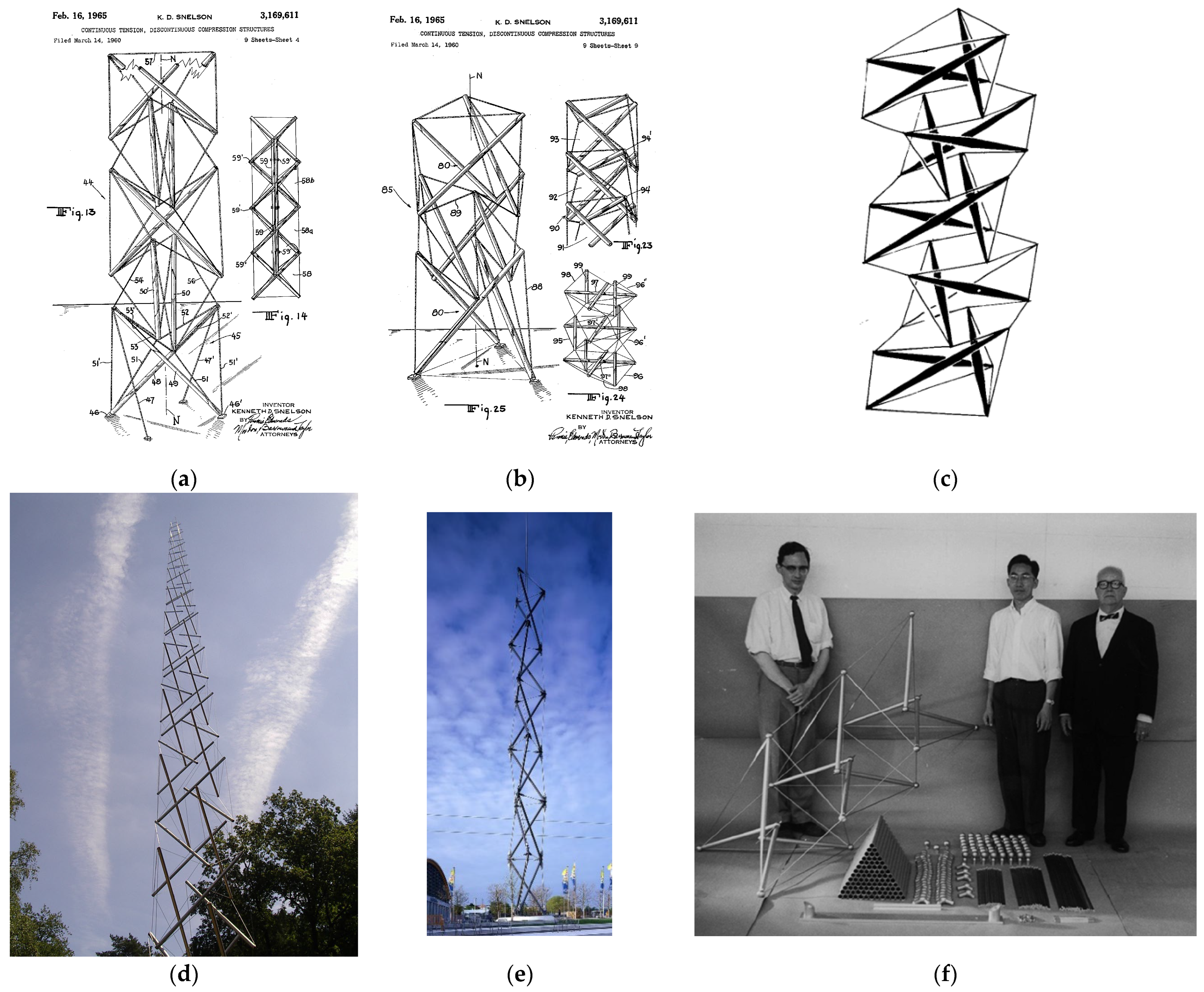
2.2. Domes and Roofs
“…a catenary suspension system can be converted into an arched structure of domical or polygonal form. By breaking up the suspension cables into increments suspending an ascending series of polygonal or circular frames stepped upwardly one within another, altitude is gained, replacing the catenary sag of the bridge cables with a rising, arched, suspension system” [31].
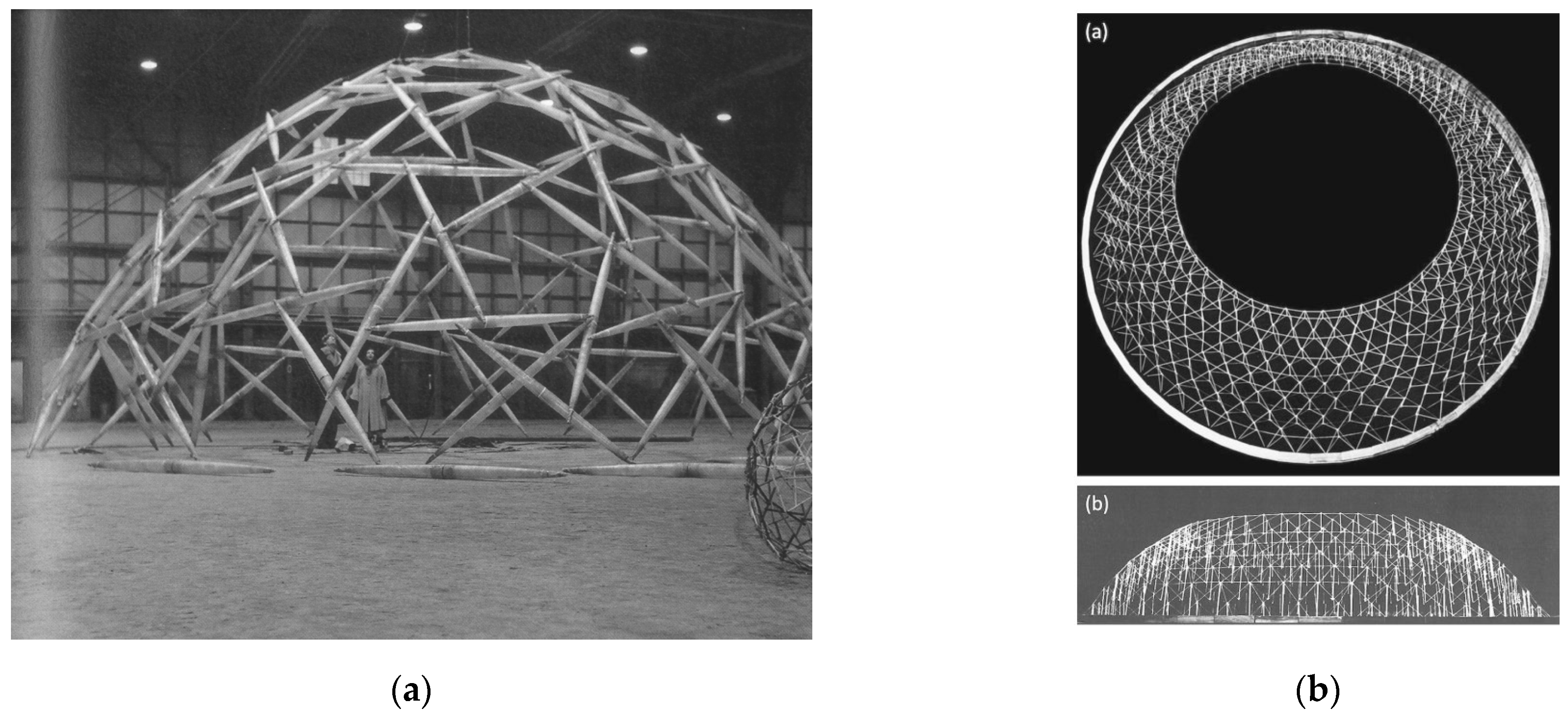
2.3. Bridges
2.4. Platforms
2.5. Drilling Machinery
2.6. Facades
3. Space Applications
3.1. Masts
3.2. Antennas
3.3. Rovers
4. Robots and Electromechanical Engineering
4.1. Sensors
4.2. Crawling Robots
4.3. Three-DoF (Degrees of Freedom)
4.4. Uniaxial Robots
4.5. Rolling Robots
4.6. Hopping and Rolling Robots
4.7. Jumping Robots
4.8. Climbing Robots
4.9. Environmental Adaptable Robots
4.10. Wheels
4.11. Underwater Robots
4.12. Bio-Inspired Robots
4.13. Unmanned Aerial Vehicles (UAVS)
5. Applications on Human Anatomy
5.1. Hand
5.2. Wrist
5.3. Cranial Vault
6. Conclusions
Author Contributions
Funding
Data Availability Statement
Acknowledgments
Conflicts of Interest
References
- Emmerich, D.G. Structures Tendues et Autotendantes; Ecole d’Architecture de Paris la Villette: Paris, France, 1988. [Google Scholar]
- Monoskop. Karl Ioganson. Available online: https://monoskop.org/Karl_Ioganson (accessed on 15 September 2022).
- Wikipedia. Karlis Johansons. Available online: https://en.wikipedia.org/wiki/Karlis_Johansons (accessed on 15 September 2022).
- Manríquez-Padilla, C.G.; Zavala-Pérez, O.A.; Pérez-Soto, G.I.; Rodríguez-Reséndiz, J.; Camarillo-Gómez, K.A. Form-Finding Analysis of a Class 2 Tensegrity Robot. Appl. Sci. 2019, 9, 2948. [Google Scholar] [CrossRef]
- Motro, R. Tensegrity: Structural Systems for the Future; Kogan Page Science: London, UK, 2003. [Google Scholar]
- Fuller, R.B. Everything I Know; Audiovisual interview. 1975. Available online: https://www.bfi.org/about-fuller/everything-i-know/ (accessed on 26 April 2023).
- Fuller, R. Tensile-Integrity Structures. U.S. Patent 3,063,521, 31 August 1959. [Google Scholar]
- Montuori, R.; Skelton, R.E. Globally stable tensegrity compressive structures for arbitrary complexity. Compos. Struct. 2017, 179, 682–694. [Google Scholar] [CrossRef]
- Skelton, R.E.; de Oliveira, M.C. Tensegrity Systems; Springer: Dordrecht, The Netherlands; Berlin/Heidelberg, Germany; London, UK; New York, NY, USA, 2009. [Google Scholar]
- Skelton, R.E.; Adhikari, R.; Pinaud, J.-P.; Chan, W. An Introduction to the Mechanics of Tensegrity Structures. In Proceedings of the 40th IEEE Conference on Decision and Control, Orlando, FL, USA, 4–7 December 2001. [Google Scholar] [CrossRef]
- Skelton, R.E.; Helton, W.J.; Adhikari, R.; Pinaud, J.-P.; Chan, W. An introduction to the mechanics of tensegrity structures. In The Mechanical Systems Design Handbook; CRC Press: Boca Raton, FL, USA, 2017; pp. 316–388. [Google Scholar]
- Gomez-Jauregui, V. Tensegrity Structures and Their Application to Architecture; Editorial Universidad de Cantabria: Santander, Spain, 2010. [Google Scholar]
- Gomez-Jauregui, V. Controversial Origins of Tensegrity. In Proceedings of the International Association for Shell and Spatial Structures (IASS) Symposium 2009, Valencia, Spain, 28 September–2 October 2009; pp. 1642–1652. [Google Scholar]
- Hanaor, A. Preliminary Investigation of Double-Layer Tensegrities; Civil-Comp Press: Edinburgh, UK, 1987; pp. 35–42. [Google Scholar] [CrossRef]
- Schodek, D.L. Structure in Sculpture; MIT Press: Cambridge, MA, USA, 1993. [Google Scholar]
- Song, K.; Scarpa, F.; Schenk, M. Form-finding of tessellated tensegrity structures. Eng. Struct. 2022, 252, 113627. [Google Scholar] [CrossRef]
- Sherbakov, S.S.; Basaran, C. On the development of tribo-fatigue as the new section of mechanics. Int. J. Mater. Struct. Integr. 2022, 14, 142–163. [Google Scholar] [CrossRef]
- Hernàndez-Juan, S.; Mirats-Tur, J.M. Tensegrity frameworks: Static analysis review. Mech. Mach. Theory 2008, 43, 859–881. [Google Scholar] [CrossRef]
- Mirats-Tur, J.M.; Hernàndez-Juan, S. Tensegrity frameworks: Dynamic analysis review and open problems. Mech. Mach. Theory 2009, 44, 1–18. [Google Scholar] [CrossRef]
- Liu, Y.; Bi, Q.; Yue, X.; Wu, J.; Yang, B.; Li, Y. A review on tensegrity structures-based robots. Mech. Mach. Theory 2021, 168, 104571. [Google Scholar] [CrossRef]
- Hernández-Montes, E.; Fernández-Ruiz, M.A.; Gil-Martín, L.M.; Merino, L.; Jara, P. Full and folded forms: A compact review of the formulation of tensegrity structures. Math. Mech. Solids 2018, 23, 944–949. [Google Scholar] [CrossRef]
- Sultan, C. Tensegrity: 60 Years of Art, Science, and Engineering. In Advances in Applied Mechanics; Elsevier: Amsterdam, The Netherlands, 2009; Volume 43, pp. 69–145. [Google Scholar] [CrossRef]
- Snelson, K. Continuous Tension, Discontinuous Compression Structures. U.S. Patent 3,169,611A, 16 February 1965. [Google Scholar]
- Emmerich, M.D.G. Structures Linéaires Autotendantes. FR 1,377,291, 6 November 1964. [Google Scholar]
- Schlaich, M. The Messeturm in Rostock—A Tensegrity Tower. J. Int. Assoc. Shell Spat. Struct. 2004, 45, 93–98. [Google Scholar]
- Snelson, K. Kennethsnelson. Available online: http://kennethsnelson.net/sculptures/towers/zig-zag-tower/ (accessed on 29 January 2023).
- Heartney, E. Kenneth Snelson: Forces Made Visible; Hudson Hills: Lenox, NY, USA, 2009. [Google Scholar]
- Pferfer, S.; Fuller, R.B.; Noguchi, I. Fuller and Noguchi: Story of a Friendship. 2011. Available online: http://www.domusweb.it/en/interviews/2011/09/01/fuller-and-noguchi-story-of-a-friendship.html (accessed on 11 November 2022).
- Fraddosio, A.; Marzano, S.; Pavone, G.; Piccioni, M.D. Morphology and self-stress design of V-Expander tensegrity cells. Compos. Part B 2016, 115, 102–116. [Google Scholar] [CrossRef]
- Marks, R.W. The Dymaxion World of Buckminster Fuller; Reinhold Publishing Corporation: New York, NY, USA, 1960. [Google Scholar]
- Fuller, R.B. Suspension Building. U.S. Patent 3,139,957A, 7 July 1964. [Google Scholar]
- Micheletti, A.; Podio-Guidugli, P. Seventy years of tensegrities (and counting). Arch. Appl. Mech. 2022, 92, 2525–2548. [Google Scholar] [CrossRef]
- Mollaert, M.M. Seoul Olympic Gymnastics Hall and Fencing Hall. Available online: https://www.tensinet.com/index.php/component/tensinet/?view=reference&id=3758 (accessed on 16 September 2022).
- Levy, M.; Jing, T.-F.; Brzozowski, A.; Freeman, G. Estadio Ciudad de La Plata (La Plata Stadium), Argentina. Struct. Eng. Int. 2013, 23, 303–310. [Google Scholar] [CrossRef]
- Oribasi, A.; Paronesso, A.; Dauner, H.-G. The new World Cycling Center in Aigle, Switzerland (Die neue Weltradsporthalle in Aigle, Schweiz). Stahlbau 2002, 71, 584–591. [Google Scholar] [CrossRef]
- Kiewitt, G. The new look of lamella roofs. In Architectural Engineering: New Structures; Fischer, R.E., Ed.; Mc-Graw-Hill/Architectural Record: New York, NY, USA, 1964; pp. 20–25. [Google Scholar]
- Geiger, D.H. Roof Structure. DE 3,579,034D1, 13 September 1990. [Google Scholar]
- Bin-Bing, W. Tensegrity structures as ‘ring beams’. J. Int. Assoc. Shell Spat. Struct. 1996, 37, 31–38. [Google Scholar]
- Peña, D.M.; Llorens, I.; Sastre, R.; Crespo, D.; Martínez, J. Application of Tensegrity to Tensile-Textile Constructions—Formfinding and Structural Analysis. J. Int. Assoc. Shell Spat. Struct. 2011, 2011, 67–81. Available online: http://hdl.handle.net/2117/19912 (accessed on 23 July 2022).
- Peña Villamil, D.M. Aplicación de los Principios del Tensegrity a las Construcciones Textiles Atirantadas. Ph.D. Thesis, Universidad Politécnica de Cataluña, Barcelona, Spain, 2012. [Google Scholar]
- Gupta, S.S.; Tan, Y.Y.; Chia, Z.P.; Pambudi, C.P.; Quek, H.; Yogiaman, C.; Tracy, K.J. Prototyping knit tensegrity shells: A design-to-fabrication workflow. SN Appl. Sci. 2020, 2, 1062. [Google Scholar] [CrossRef]
- Mortera Aguilar, A. Arquitectura Tensegrity con Bambú. Available online: https://worldbamboo.net/3cmb2016/Mart%C3%ADn%20Mortera.pdf (accessed on 21 January 2023).
- Eekhout, M. Architecture in Space Structures; Uitgeverij 010 Publishers: Rotterdam, The Netherlands, 1989. [Google Scholar]
- Motro, R. Tensegrity Systems for Double-Layer Space Structures. In Non-Conventional Structures, Proceedings of the International Conference on the Design and Construction of Non-Conventional, 8–10 December 1987, London, UK; Civil-Comp Ltd.: Edinburgh, UK, 1987; pp. 43–51. [Google Scholar]
- Liapi, K.A.; Kim, J. A Parametric Approach to the Design of Vaulted Tensegrity Networks. Int. J. Archit. Comput. 2004, 2, 245–262. [Google Scholar] [CrossRef]
- Liapi, K.; Jinman, K. Tensegrity Structures of Helical Shape: A Parametric Approach. In Proceedings of the 27th eCAADe Conference, Istanbul, Turkey, 16–19 September 2009; pp. 53–58. [Google Scholar] [CrossRef]
- Gomez-Jauregui, V.; Quilligan, M.; Manchado, C.; Otero, C. Design, Fabrication and Construction of a Deployable Double-Layer Tensegrity Grid. Struct. Eng. Int. 2018, 28, 13–20. [Google Scholar] [CrossRef]
- Kawaguchi, K.; Ohya, S.; Vormus, S. Long-Term Monitoring of White Rhino, Building with Tensegrity Skeletons; Institute of Industrial Science, The University of Tokyo: Tokyo, Japan, 2001. [Google Scholar]
- Feng, Y.; Yuan, X.; Samy, A. Analysis of new wave-curved tensegrity dome. Eng. Struct. 2022, 250, 113408. [Google Scholar] [CrossRef]
- Asghari, R.; Abedi, K.; Chenaghlou, M.R.; Shekastehband, B. Retrofitting of hybrid cable domes against strut buckling using di-pyramid (DP) module and force-limiting devices (FLD). Thin-Walled Struct. 2022, 180, 109737. [Google Scholar] [CrossRef]
- Ogunsote, O.O.; Arum, C.; Prucnal-Ogunsote, B. Aesthetic and Economic Imperatives in the Design of the Kurilpa Pedestrian Bridge as a Functional Tensegrity Structure. Infrastruct. Econ. Dev. Built Environ. 2018, pp. 249–260. Available online: https://www.proquest.com/wire-feeds/level-1-visual-inspection-kurilpa-bridge/docview/2038434379/se-2 (accessed on 5 July 2022).
- Rhode-Barbarigos, L.; Bel Hadj Ali, N.; Motro, R.; Smith, I.F.C. Designing tensegrity modules for pedestrian bridges. Eng. Struct. 2010, 32, 1158–1167. [Google Scholar] [CrossRef]
- Motro, R.; Maurin, B.; Silvestri, C. Tensegrity rings and the hollow rope. In Proceedings of the IASS International Symposium, Beijing, China, 16–19 October 2006; pp. 470–471. [Google Scholar]
- Veuve, N.; Dalil Safaei, S.; Smith, I.F.C. Deployment of a Tensegrity Footbridge. J. Struct. Eng. 2015, 141, 04015021. [Google Scholar] [CrossRef]
- Veuve, N.; Sychterz, A.C.; Smith, I.F.C. Adaptive control of a deployable tensegrity structure. Eng. Struct. 2017, 152, 14–23. [Google Scholar] [CrossRef]
- Hrazmi, I.; Averseng, J.; Quirant, J.; Jamin, F. Deployable double layer tensegrity grid platforms for sea accessibility. Eng. Struct. 2021, 231, 111706. [Google Scholar] [CrossRef]
- Motro, R. Tensarch: A tensegrity double layer grid prototype. Space Struct. 5 2002, 1, 57–66. [Google Scholar] [CrossRef]
- Gilewski, W.; Klosowska, J.; Obara, P. Verification of Tensegrity Properties of Kono Structure and Blur Building. Procedia Eng. 2016, 153, 173–179. [Google Scholar] [CrossRef]
- Khaled, M.S.; Chen, M.; Losoya, E.Z.; Rodriguez, L.A.; Guildin, E.; Skelton, R.E. Tensegrity laboratory drilling rig for earth and space drilling, mining, and exploration. Int. J. Solids Struct. 2022, 252, 111785. [Google Scholar] [CrossRef]
- Kabošová, L.; Kormaníková, E.; Kmet, S.; Katunský, D. Shape-changing tensegrity-membrane building skin. In Proceedings of the 4th International Scientific Conference Structural and Physical Aspects of Construction Engineering (SPACE 2019), Strbske Pleso, Slovakia, 13–15 November 2019. [Google Scholar] [CrossRef][Green Version]
- Miranda, R.; Babilio, E.; Peña, D.; Santos, F.; Fraternali, F. Mechanics of Energy Harvesters Based on Tensegrity Solar Facades. In IOP Conf. Series: Materials Science and Engineering; IOP Publishing: Bristol, UK, 2020. [Google Scholar] [CrossRef]
- Tibert, G. Deployable Tensegrity Structures for Space Applications. Ph.D. Thesis, Royal Institute of Technology, Stockholm, Sweden, 2002. [Google Scholar]
- Furuya, H. Concept of Deployable Tensegrity Structures in Space Application. Int. J. Space Struct. 1992, 7, 143–151. [Google Scholar] [CrossRef]
- Tibert, G.; Pellegrino, S. Deployable Tensegrity Masts. In Proceedings of the 44th AIAA/ASME/ASCE/AHS/ASC Structures, Structural Dynamics, and Materials Conference, Norfolk, VA, USA, 7–10 April 2003. [Google Scholar]
- Zawadzki, A.; Sabouni-Zawadzka, A.A. In Search of Lightweight Deployable Tensegrity Columns. Appl. Sci. 2020, 10, 8676. [Google Scholar] [CrossRef]
- Knight, B.F. Deployable Antenna Kinematics Using Tensegrity Structure Design. Ph.D. Thesis, University of Florida, Gainesville, FL, USA, 2000. [Google Scholar]
- Knight, B.; Duffy, J.; Crane, C.; Rooney, J. Deployable Antenna. U.S. Patent WO2001076011A2, 11 October 2001. [Google Scholar]
- Tibert, G.; Pellegrino, S. Deployable Tensegrity Reflectors for Small Satellites. J. Spacecr. Rocket. 2002, 39, 702–709. [Google Scholar] [CrossRef]
- Ganga, P.L.; Micheletti, A.; Podio-Guidugli, P.; Scolamiero, L.; Tibert, G.; Zolesi, V. Tensegrity Rings for Deployable Space Antennas: Concept, Design, Analysis, and Prototype Testing. In Variational Analysis and Aerospace Engineering. Springer Optimization and Its Applications; Frediani, A., Mohammadi, B., Pironneau, O., Cipolla, V., Eds.; Springer: Cham, Switzerland, 2016; p. 116. [Google Scholar] [CrossRef]
- Scolamiero, L.G.; Zolesi, V.; Ganga, P.L.; Podio-Guidugli, P.; Tibert, G.; Micheletti, A. A Deployable Tensegrity Structure, Especially for Space Applications. EP 2,828,928A1, 18 May 2016. [Google Scholar]
- Vespignani, M.; Friesen, J.M.; SunSpiral, V.; Bruce, J. Design of SUPERball v2, a Compliant Tensegrity Robot for Absorbing Large Impacts. In Proceedings of the 2018 IEEE/RSJ International Conference on Intelligent Robots and Systems (IROS), Madrid, Spain, 1–5 October 2018; pp. 2865–2871. [Google Scholar] [CrossRef]
- Ingber, D.E. Cellular tensegrity: Defining new rules of biological design that govern the cytoskeleton. J. Cell Sci. 1993, 104, 613–627. [Google Scholar] [CrossRef] [PubMed]
- Ingber, D.E. Tensegrity-based mechanosensing from macro to micro. Prog. Biophys. Mol. Biol. 2008, 97, 163–179. [Google Scholar] [CrossRef]
- Sultan, C.; Skelton, R. A force and torque tensegrity sensor. Sens. Actuators A. Phys. 2004, 112, 220–231. [Google Scholar] [CrossRef]
- Paul, C.; Roberts, J.W.; Lipson, H.; Valero Cuevas, F.J. Gait production in a tensegrity based robot. In Proceedings of the 12th International Conference on Advanced Robotics (ICAR ’05), Seattle, WA, USA, 18–20 July 2005; pp. 216–222. [Google Scholar] [CrossRef]
- Paul, C.; Valero Cuevas, F.J.; Lipson, H. Design and Control of Tensegrity Robots for Locomotion. IEEE Trans. Robot. 2006, 22, 944–957. [Google Scholar] [CrossRef]
- Shibata, M.; Saijyo, F.; Hirai, S. Crawling by Body Deformation of Tensegrity Structure Robots. In Proceedings of the 2009 IEEE International Conference on Robotics and Automation, Kobe, Japan, 12–17 May 2009. [Google Scholar] [CrossRef]
- Li, B.; Wenjuan, D.; Wenjuan, L. Dynamic Modeling and Controlling for the Crawling. In Proceedings of the 2017 IEEE 7th Annual International Conference on CYBER Technology in Automation, Control, and Intel-ligent Systems (CYBER), Honolulu, HI, USA, 31 July–4 August 2017. [Google Scholar] [CrossRef]
- Mirats-Tur, J.M.; Camps, J. A Three-DoF Actuated Robot. IEEE Robot. Autom. Mag. 2011, 18, 96–103. [Google Scholar] [CrossRef]
- Cui, J.; Wang, P.; Sun, T.; Ma, S.; Liu, S.; Kang, R.; Guo, F. Design and experiments of a novel quadruped robot with. Mech. Mach. Theory 2022, 171, 104781. [Google Scholar] [CrossRef]
- Böhm, V.; Zimmermann, K. Vibration-driven mobile robots based on single actuated tensegrity structures. In Proceedings of the 2013 IEEE International Conference on Robotics and Automation, Karlsruhe, Germany, 6–10 May 2013. [Google Scholar] [CrossRef]
- Raducanu, M. Stable Self-Balancing System for Building Component. FR WO02081832A1, 9 April 2001. [Google Scholar]
- Koizumi, Y.; Mizuho, S.; Hirai, S. Rolling Tensegrity Driven by Pneumatic Soft Actuators. In Proceedings of the 2012 IEEE International Conference on Robotics and Automation, Saint Paul, MN, USA, 14–18 May 2012. [Google Scholar] [CrossRef]
- Wang, Z.; Li, K.; He, Q.; Cai, S. A Light-Powered Ultralight Tensegrity Robot with High Deformability and Load Capacity. Adv. Mater. 2019, 31, 1806849. [Google Scholar] [CrossRef] [PubMed]
- Sabelhaus, A.P.; Bruce, J.; Caluwaerts, K.; Manovi, P.; Firoozi, R.F.; Dobi, S.; Agogino, A.M.; SunSpiral, V. System Design and Locomotion of SUPERball, an Untethered Tensegrity Robot. In Proceedings of the 2015 IEEE International Conference on Robotics and Automation (ICRA), Seattle, WA, USA, 26–30 July 2015; pp. 2867–2873. [Google Scholar] [CrossRef]
- Khazanov, M.; Humphreys, B.; Keat, W.; Rieffel, J. Exploiting Dynamical Complexity in a Physical Tensegrity Robot to Achieve Locomotion. In Proceedings of the ECAL 2013: The 12th European Conference on Artificial Life, Taormina, Italy, 2–6 September 2013. [Google Scholar] [CrossRef]
- Bruce, J.; Caluwaerts, K.; Iscen, A.; Sabelhaus, A.P.; SunSpiral, V. Design and Evolution of a Modular Tensegrity Robot Platform. In Proceedings of the 2014 IEEE International Conference on Robotics & Automation (ICRA), Hong Kong, China, 31 May–7 June 2014; pp. 3483–3489. [Google Scholar] [CrossRef]
- Vespignani, M.; Ercolani, C.; Friesen, J.M.; Bruce, J. Steerable Locomotion Controller for Six-struts Icosahedral Tensegrity Robots. In Proceedings of the 2018 IEEE/RSJ International Conference on Intelligent Robots and Systems (IROS), Madrid, Spain, 1–5 October 2018. [Google Scholar] [CrossRef]
- Du, W.; Ma, S.; Wang, M.; Hirai, S. Force Analytic Method for Rolling Gaits of Tensegrity Robots. IEEE/ASME Trans. Mechatron. 2016, 21, 2249–2259. [Google Scholar] [CrossRef]
- Chang, J.; Li, B.; Liu, W.; Du, W. The Path Planning Method of Tensegrity Robot. In Proceedings of the 2018 IEEE 8th Annual International Conference, Tianjun, China, 19–23 July 2018. [Google Scholar]
- Kim, K.; Chen, L.-H.; Cera, B.; Daly, M.; Zhu, E.; Despois, J.; Agogino, A.K.; SunSpiral, V.; Agogino, A.M. Hopping and Rolling Locomotion with Spherical Tensegrity Robots. In Proceedings of the 2016 IEEE/RSJ International Conference on Intelligent Robots and Systems (IROS), Daejeon, Republic of Korea, 9–14 October 2016. [Google Scholar] [CrossRef]
- Schorr, P.; Zentner, L.; Zimmermann, K.; Böhm, V. Jumping locomotion system based on a multistable tensegrity structure. Mech. Syst. Signal Process. 2021, 152, 107384. [Google Scholar] [CrossRef]
- Chen, L.-H.; Cera, B.; Zhu, E.L.; Edmunds, R.; Rice, F.; Bronars, A.; Tang, E.; Malekshahi, S.R.; Romero, O.; Agogino, A.K.; et al. Inclined Surface Locomotion Strategies for Spherical Tensegrity Robots. In Proceedings of the 2017 IEEE/RSJ International Conference on Intelligent Robots and Systems (IROS), Vancouver, BC, Canada, 24–28 September 2017. [Google Scholar] [CrossRef]
- Friesen, J.M.; Glick, P.; Fanton, M.; Manovi, P.; Xydes, A.; Bewley, T.; Sunspiral, V. The Second Generation Prototype of A Duct Climbing Tensegrity. In Proceedings of the 2016 IEEE International Conference on Robotics and Automation (ICRA), Stockholm, Sweden, 16–21 May 2016; pp. 2123–2128. [Google Scholar] [CrossRef]
- Li, W.-Y.; Takata, A.; Nabae, H.; Endo, G.; Suzumori, K. Shape Recognition of a Tensegrity with Soft Sensor Threads and Artificial Muscles Using a Recurrent Neural Network. IEEE Robot. Autom. Lett. 2021, 6, 6228–6234. [Google Scholar] [CrossRef]
- Kobayashi, R.; Nabae, H.; Endo, G.; Suzumori, K. Soft Tensegrity Robot Driven by Thin Artificia lMuscles for the Exploration of Unknown Spatial Configurations. IEEE Robot. Autom. Lett. 2022, 7, 5349–5356. [Google Scholar] [CrossRef]
- Crowther, G.; Apostolopoulos, D.; Heys, S. Tensegrital wheel for enhanced planetary surface mobility: Part 1—Design and evolution. J. Terramech. 2022, 100, 11–24. [Google Scholar] [CrossRef]
- Shibata, M.; Sakagami, N. Deformable tensegrity structure underwater robot with a transformation mechanism. Artif. Life Robot. 2020, 25, 100–105. [Google Scholar] [CrossRef]
- Xu, P.; Zheng, J.; Liu, J.; Liu, X.; Wang, X.; Wang, S.; Guan, T.; Fu, X.; Xu, M.; Xie, G.; et al. Deep-Learning Assisted Underwater 3D Tactile Tensegrity. Research 2023, 6, 0062. [Google Scholar] [CrossRef] [PubMed]
- Shintake, J.; Zappetti, D.; Peter, T.; Ikemoto, Y.; Floreano, D. Bio-inspired Tensegrity Fish Robot. In Proceedings of the 2020 IEEE International Conference on Robotics and Automation (ICRA), Paris, France, 31 May–31 August 2020; pp. 2887–2892. [Google Scholar] [CrossRef]
- Flemons, T. Intension Designs. Available online: http://intensiondesigns.ca/bones-of-tensegrity/ (accessed on 20 September 2022).
- Levin, S.M. The tensegrity-truss as a model for spine mechanics: Biotensegrity. J. Mech. Med. Biol. 2011, 2, 375–388. [Google Scholar] [CrossRef]
- Levin, S.M. Biotensegrity. Available online: http://biotensegrity.com/ (accessed on 20 October 2022).
- Misletz, B.T.; Park, I.-W.; Lemons, T.E.; Agogino, A.K.; Quinn, R.D.; SunSpiral, V. Design and Control of Modular Spine-Like Tensegrity Structures. In Proceedings of the World Conference of the International Association for Structural Control and Monitoring (IACSM), Barcelona, Spain, 15–17 June 2014. [Google Scholar]
- Feng, X.; Wu, Z.; Wang, Z.; Luo, J.; Xu, X.; Qiu, Z. Design and experiments of a bio-inspired tensegrity spine robot for active space debris capturing. J. Phys. Conf. Ser. 2021, 1885, 052024. [Google Scholar] [CrossRef]
- Oh, C.L.; Choong, K.K.; Nichimura, T.; Kim, J.-Y. Multi-Directional Shape Change Analysis of Biotensegrity Model Mimiching Human Spine Curvature. Appl. Sci. 2022, 125, 2377. [Google Scholar] [CrossRef]
- Zha, J.; Wu, X.; Kroeger, J.; Perez, N.; Mueller, M.W. A collision-resilient aerial vehicle with icosahedron tensegrity structure. In Proceedings of the 2020 IEEE/RSJ International Conference on Intelligent Robots and Systems (IROS), Las Vegas, NV, USA, 24 October 2020–24 January 2021; pp. 1407–1412. [Google Scholar] [CrossRef]
- Li, W.-Y.; Nabae, H.; Endo, G.; Suzumori, K. New Soft Robot Hand Configuration with Combined Biotensegrity and Thin Artificial Muscle. IEEE Robot. Autom. Lett. 2020, 5, 4345–4351. [Google Scholar] [CrossRef]
- Lee, G.; Hong, G.Y.; Choi, Y. Tendon-Driven Compliant Prosthetic Wrist Consisting of Three Rows Based on the Concept of Tensegrity Structure. IEEE Robot. Autom. Lett. 2021, 6, 3956–3963. [Google Scholar] [CrossRef]
- Scarr, G. A model of the cranial vault as a tensegrity structure, and its significance to normal and abnormal cranial development. Int. J. Osteopath. Med. 2008, 11, 80–89. [Google Scholar] [CrossRef]
- European Patent Office. Espacenet. Available online: https://worldwide.espacenet.com/advancedSearch (accessed on 8 May 2023).
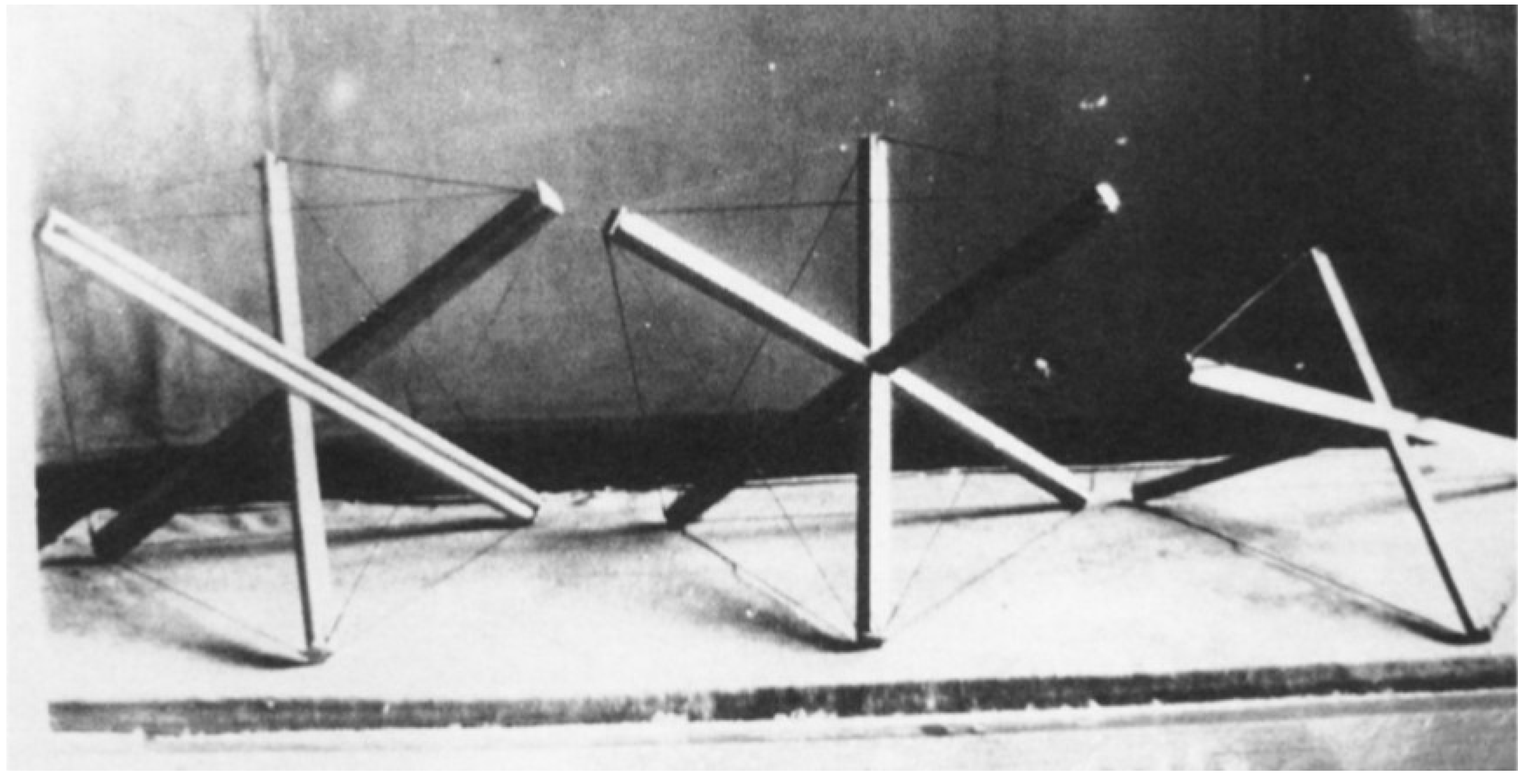
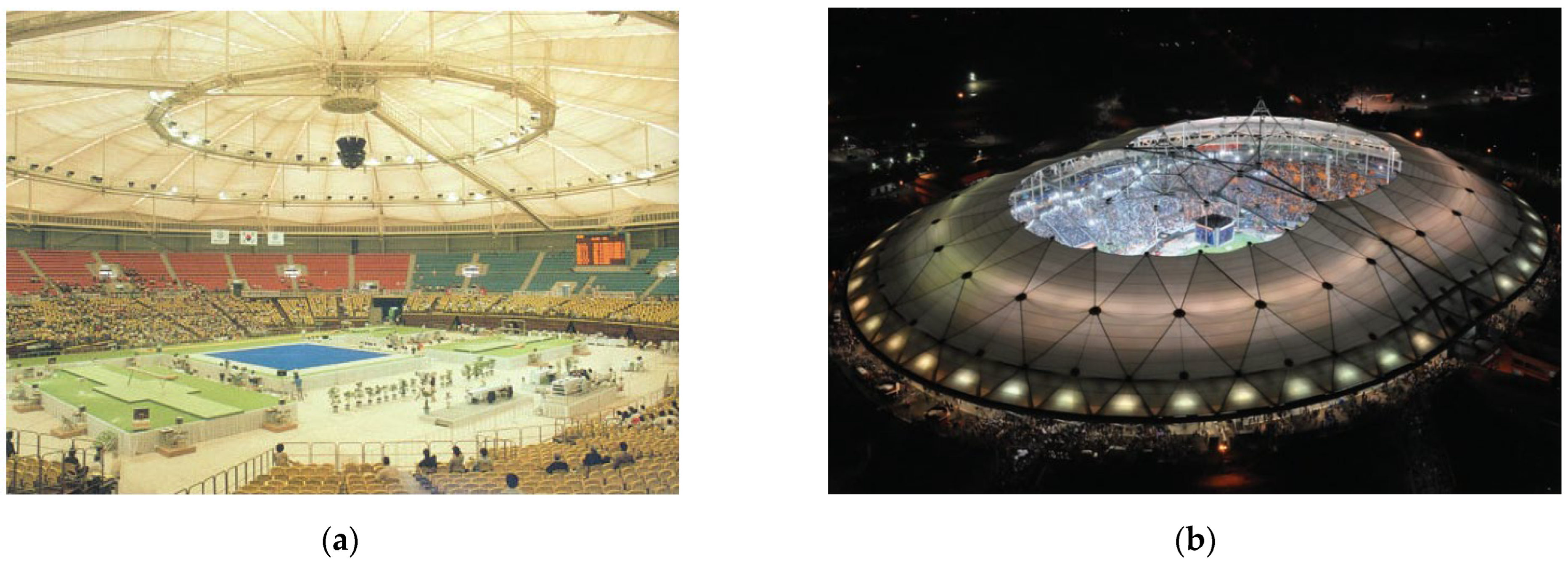


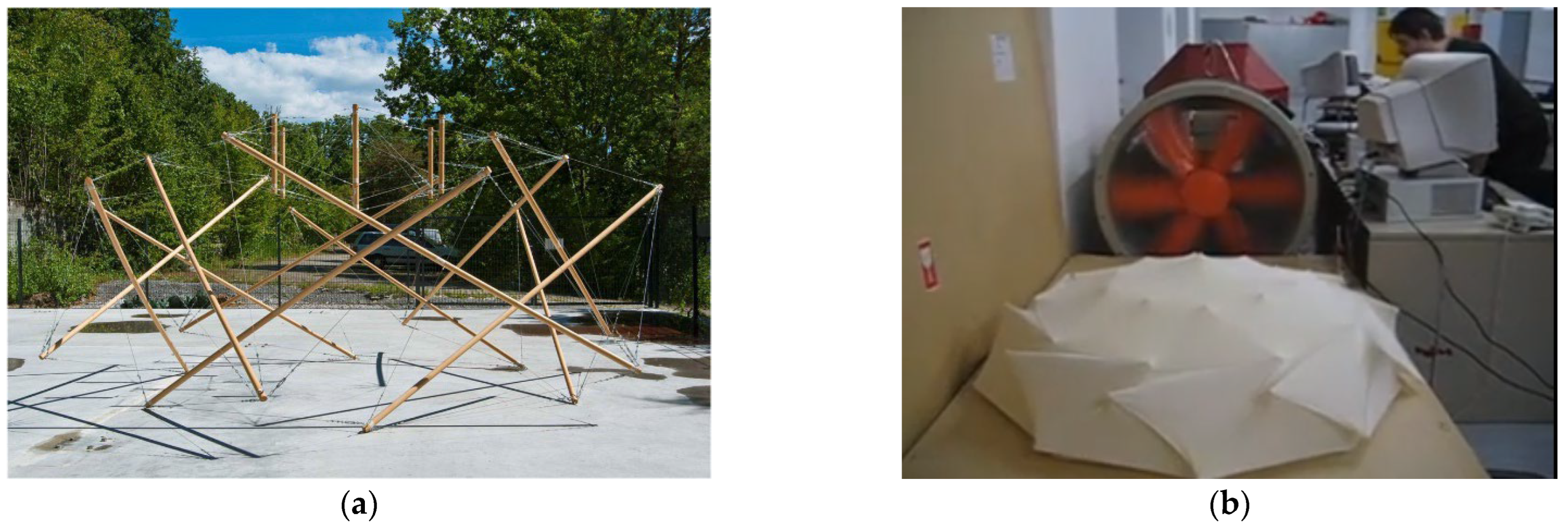
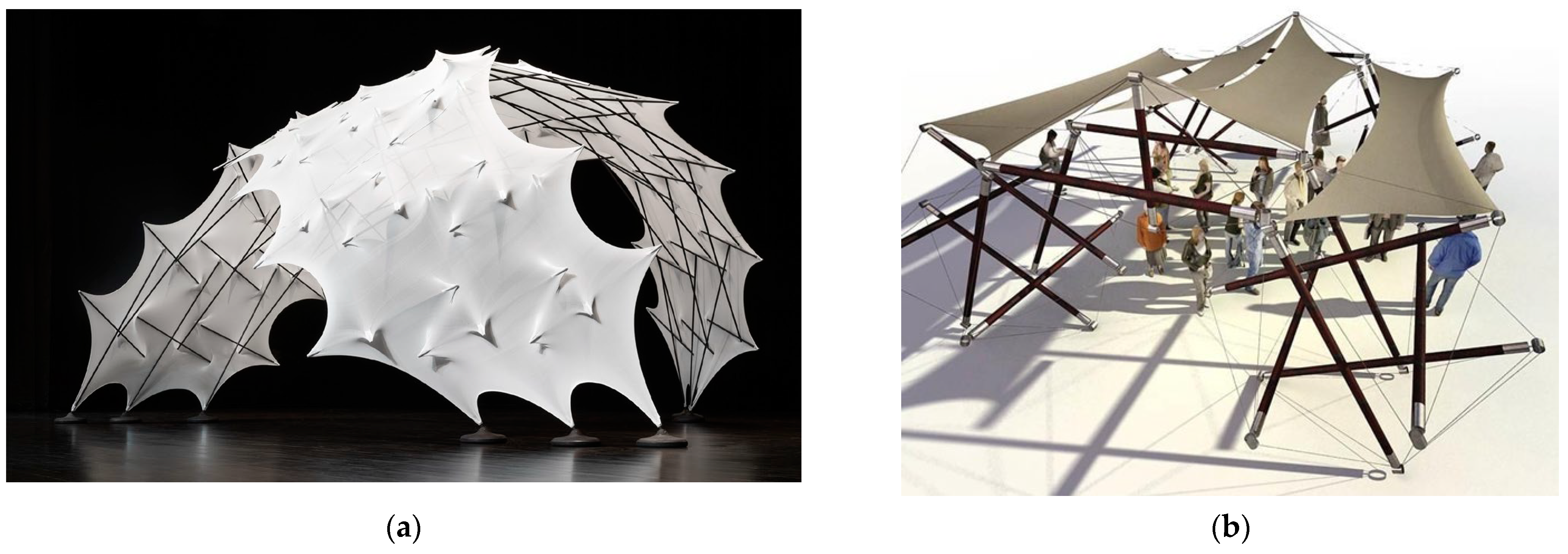
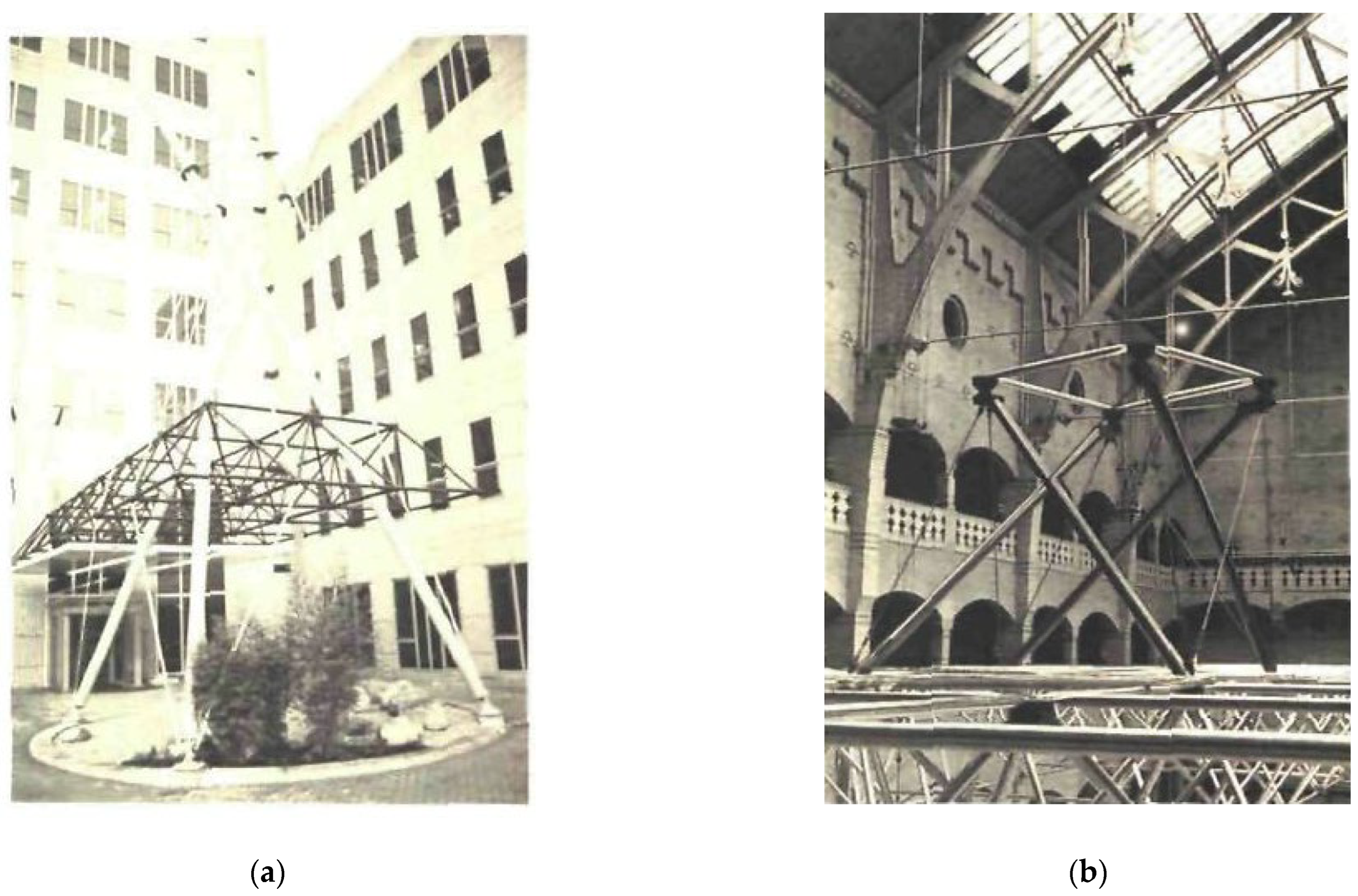
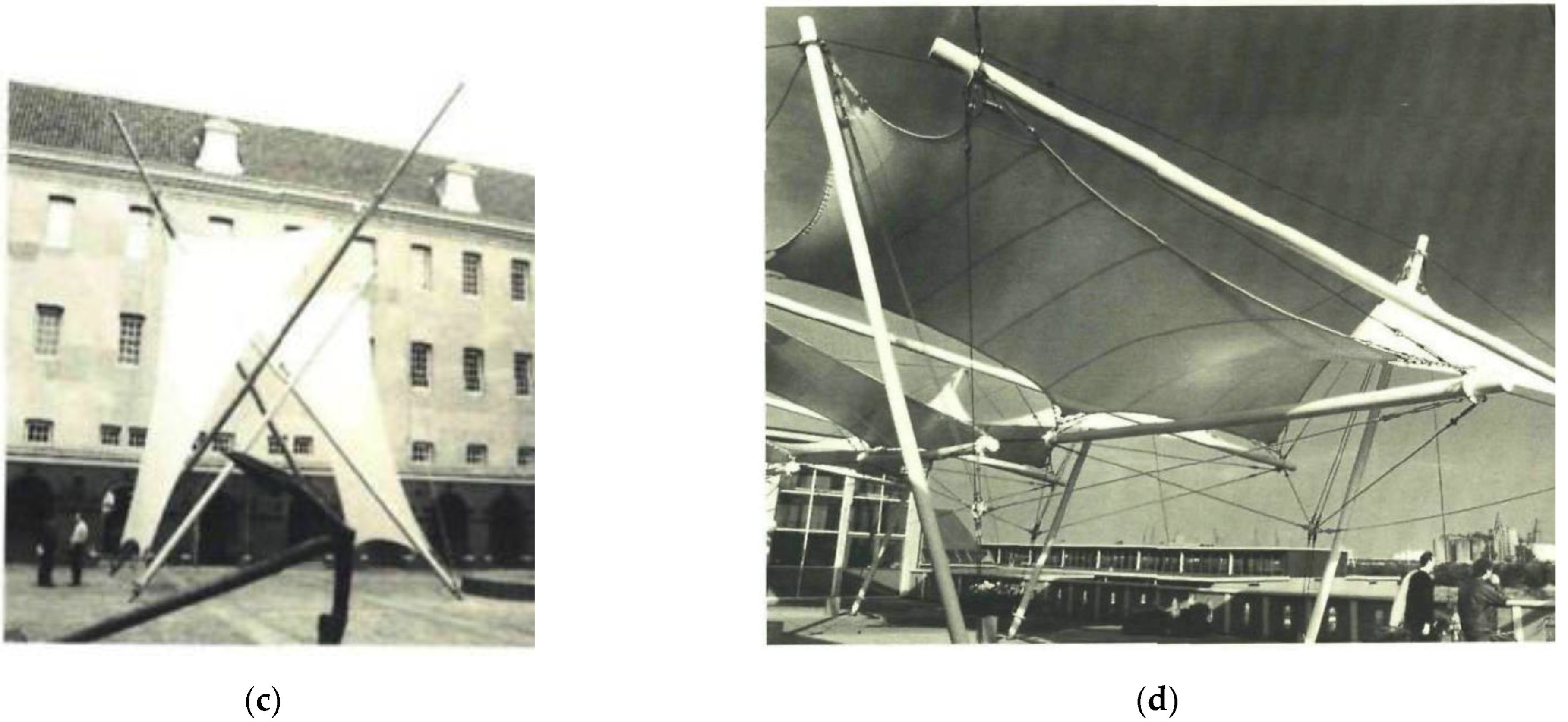
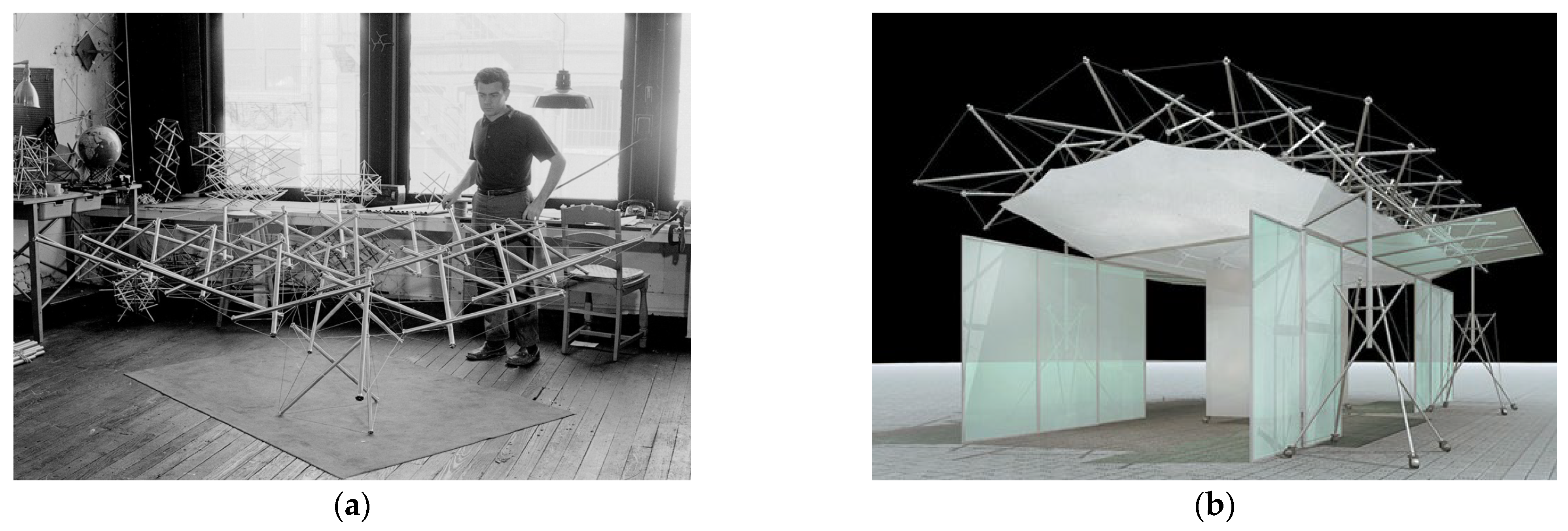
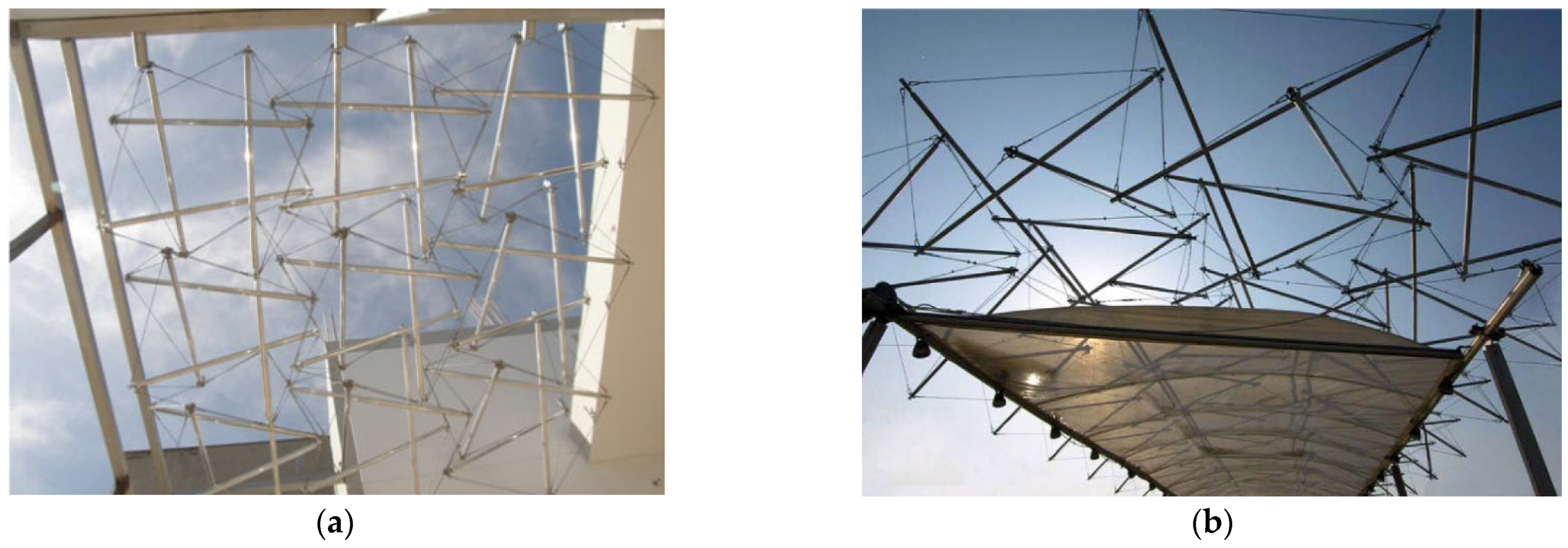
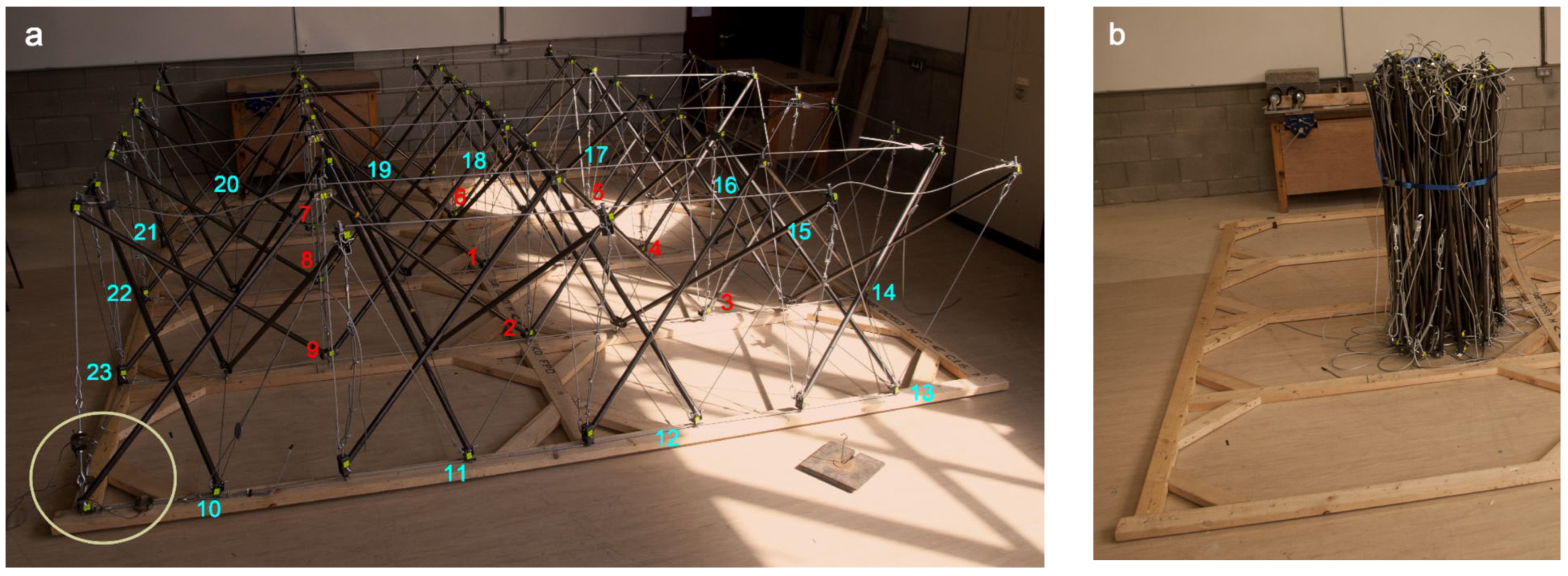
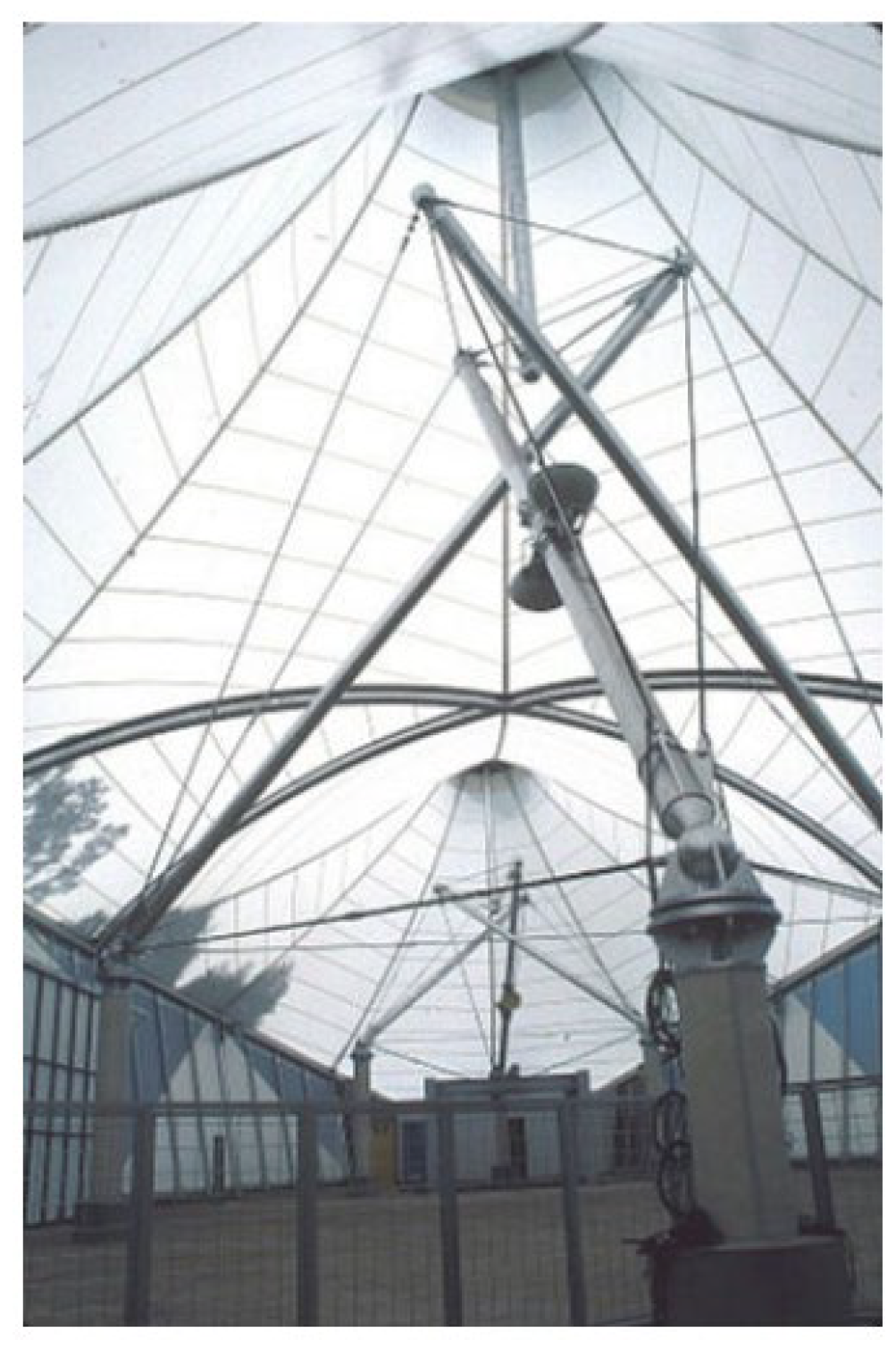

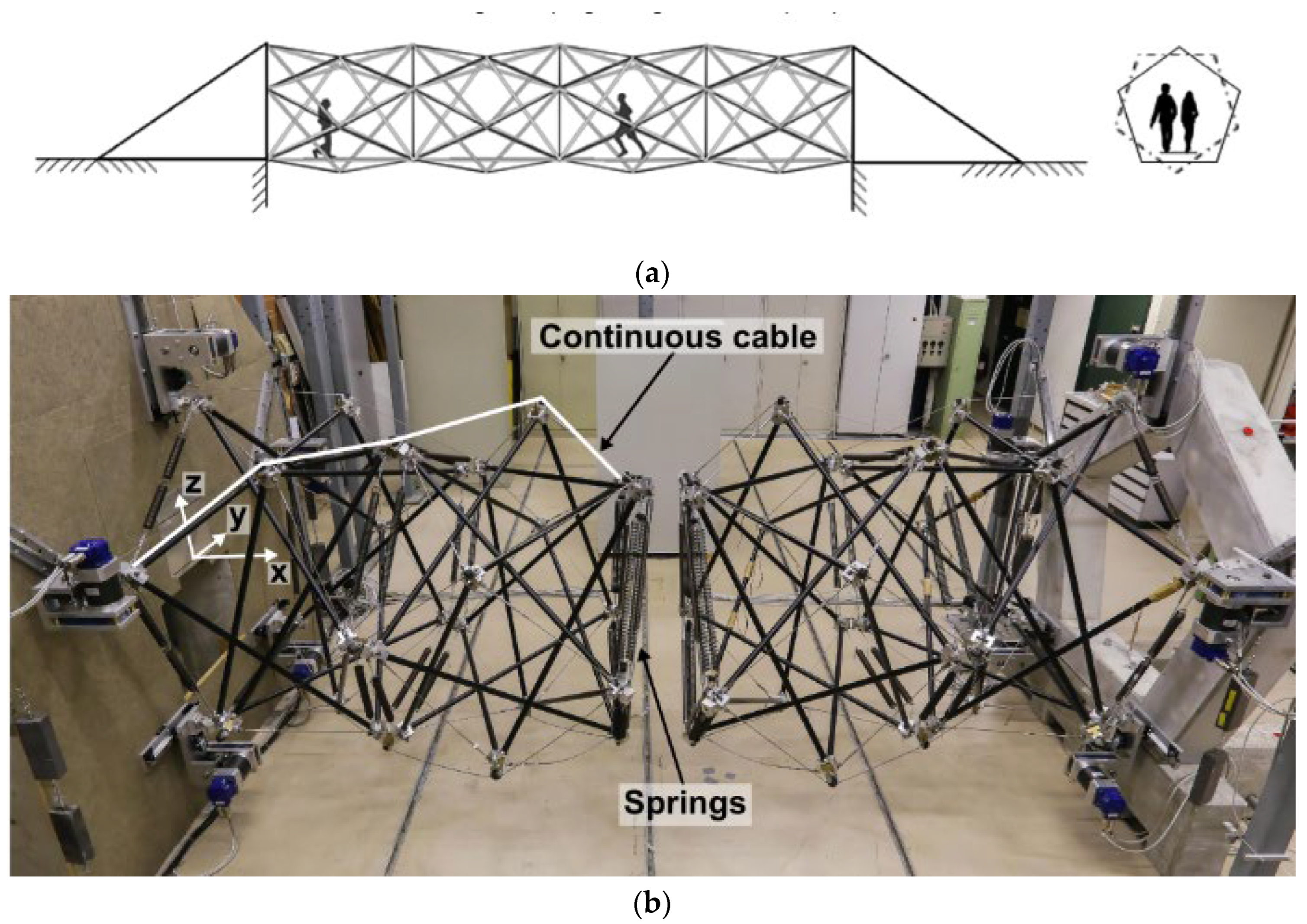


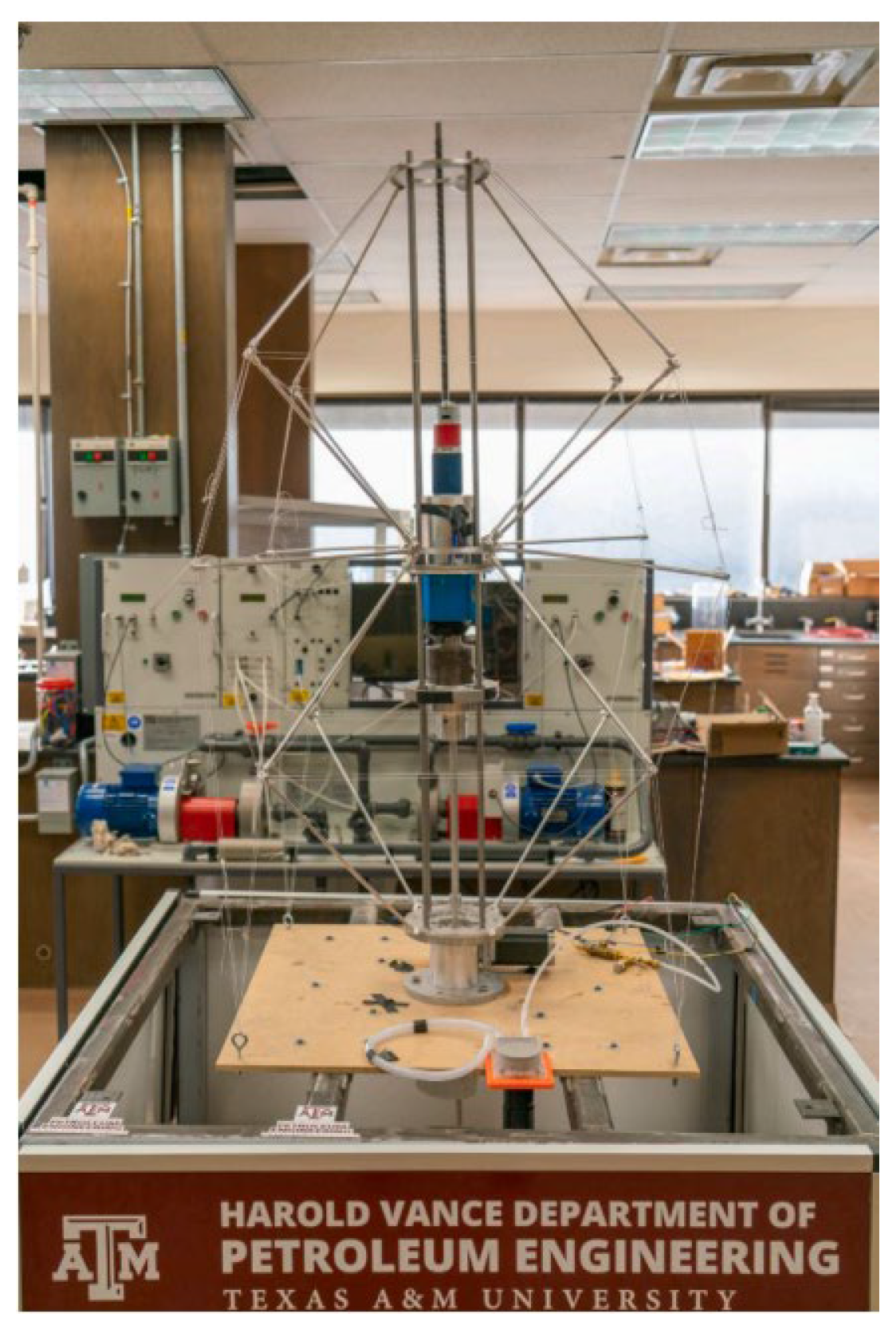

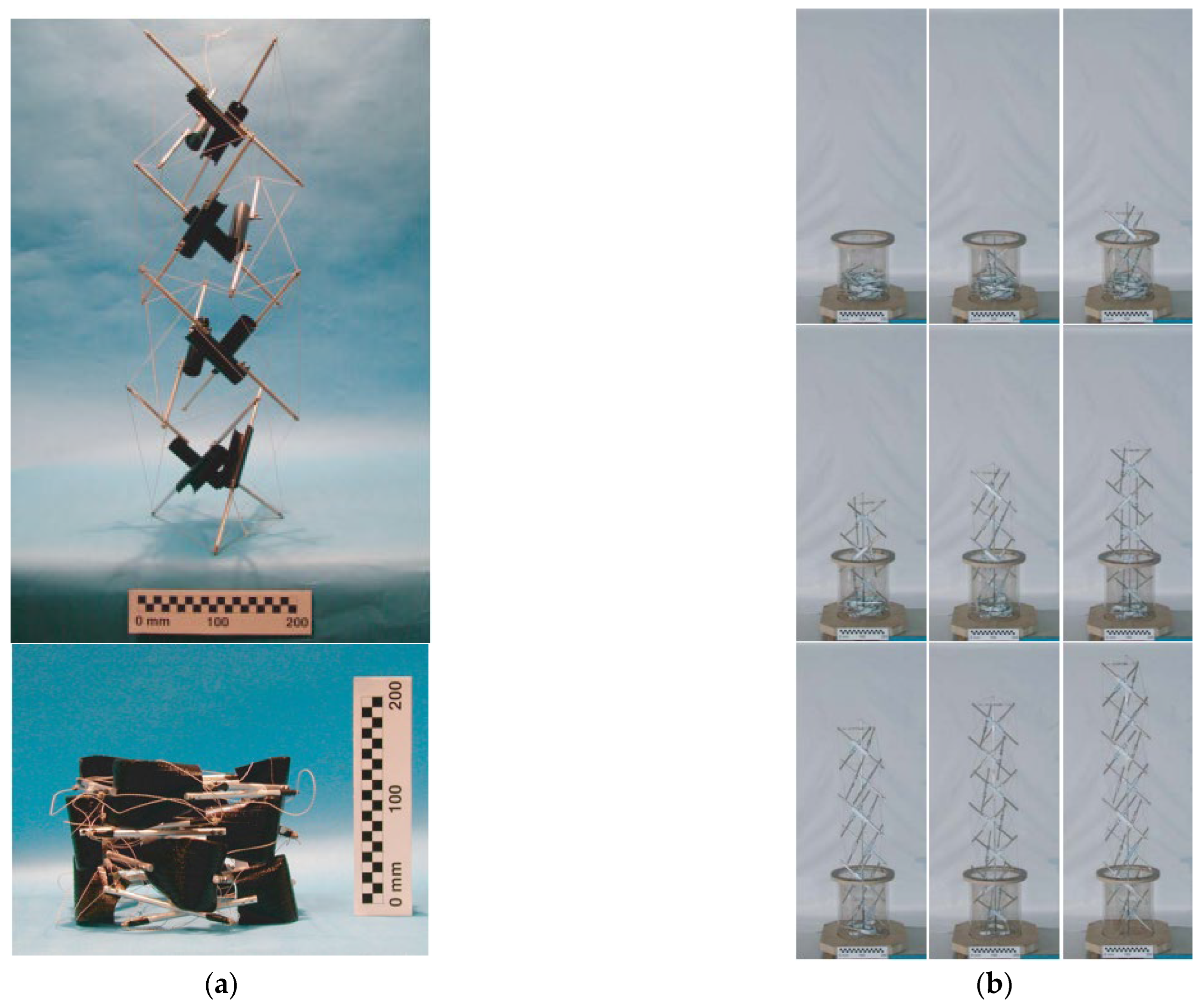

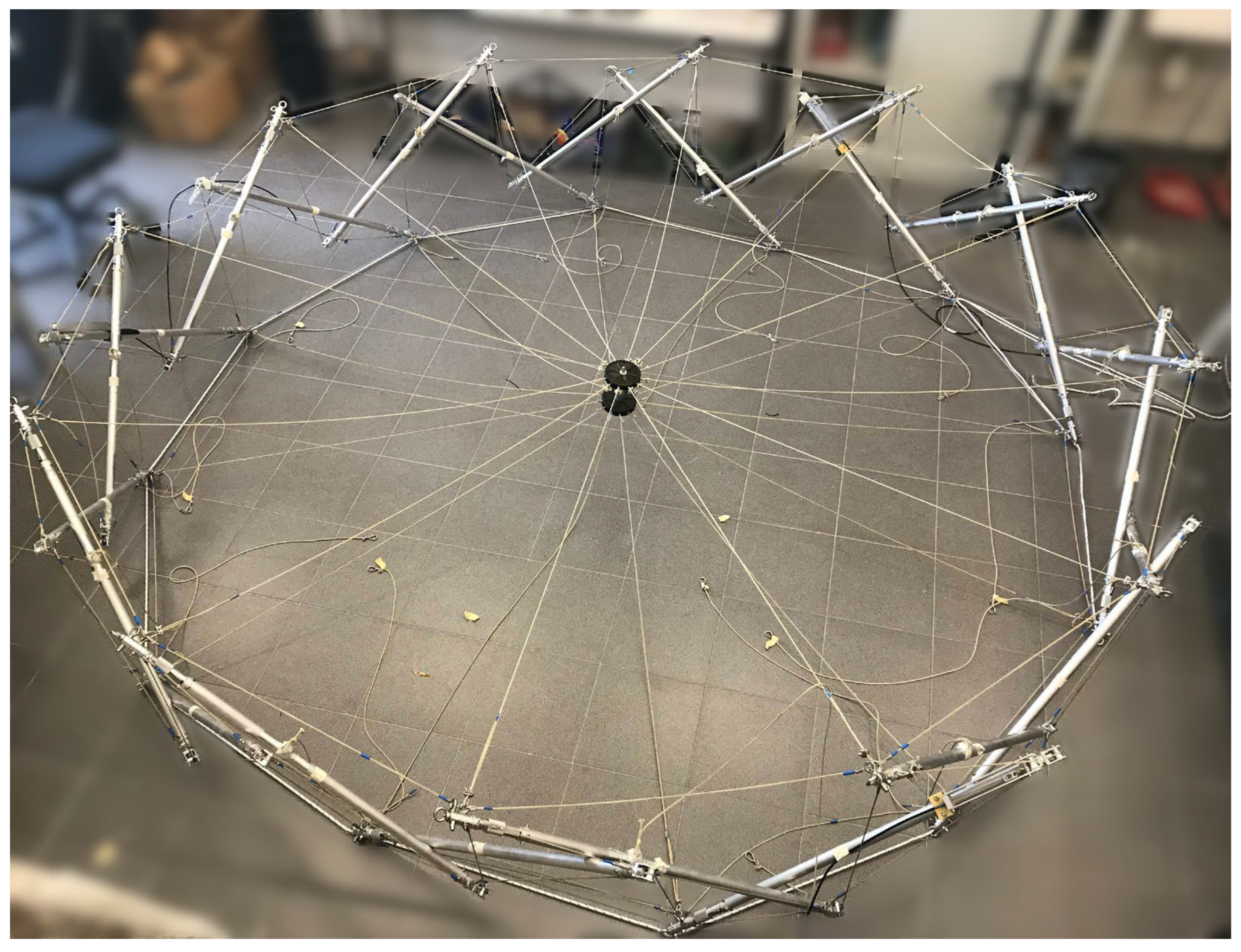



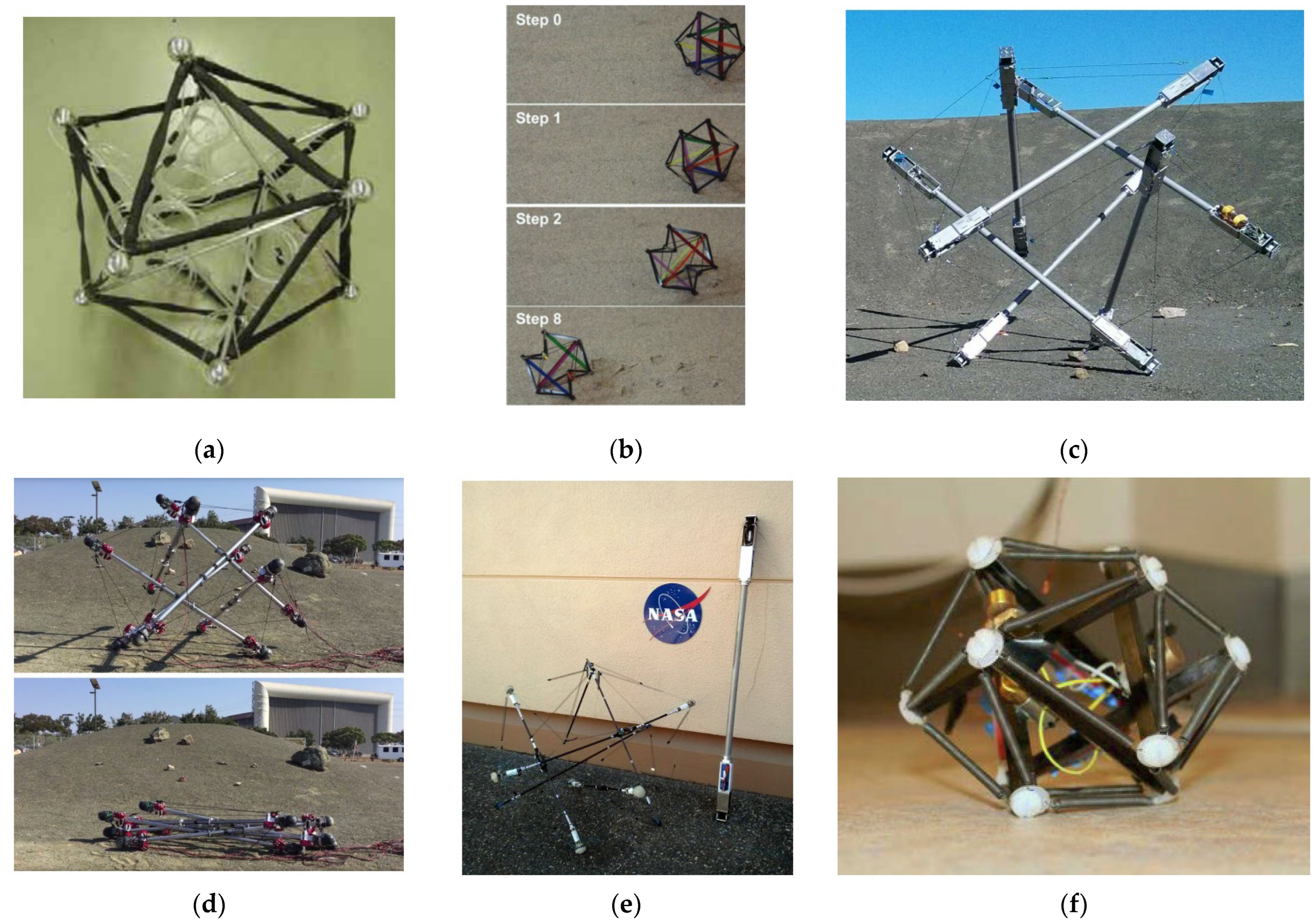
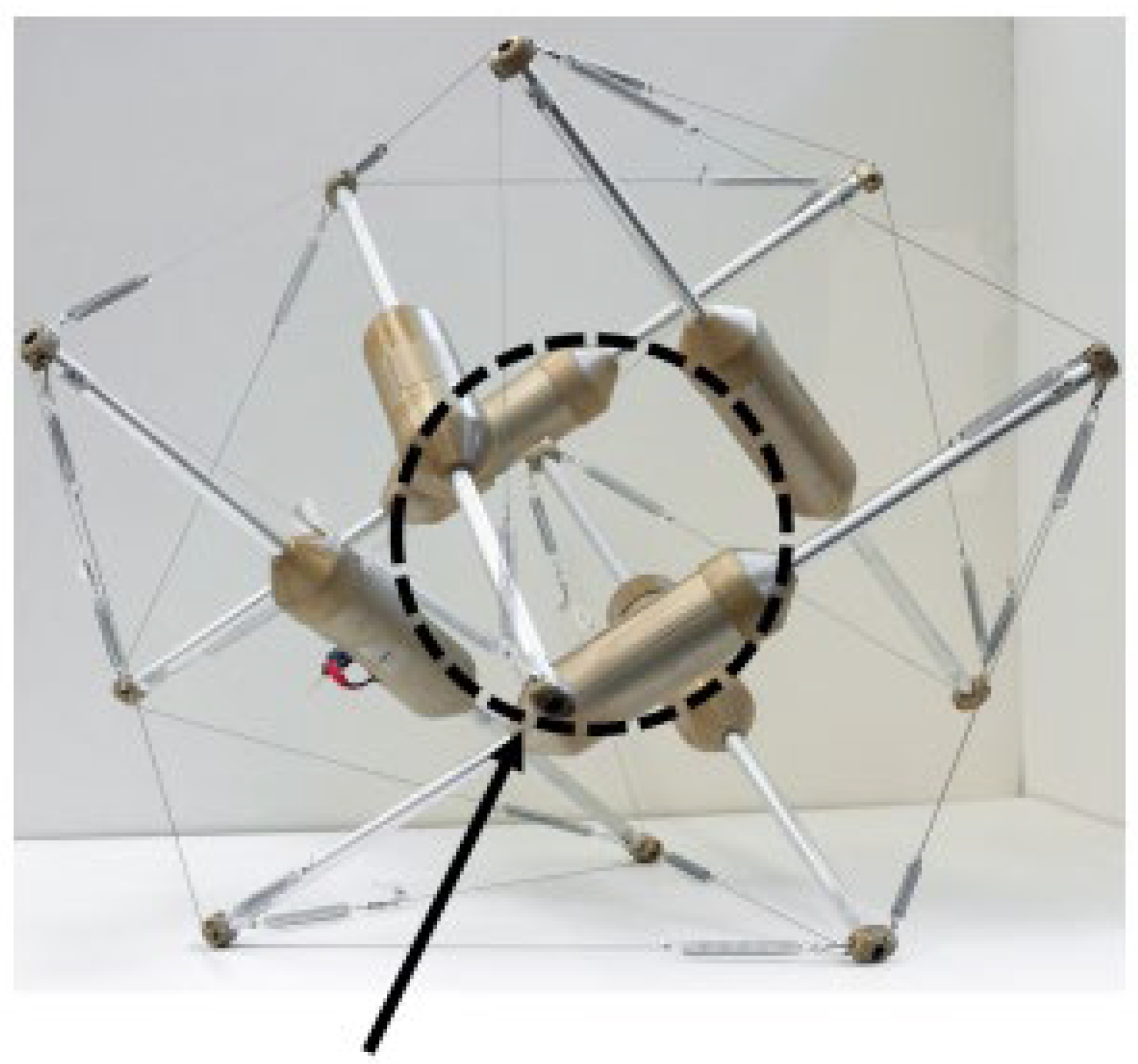

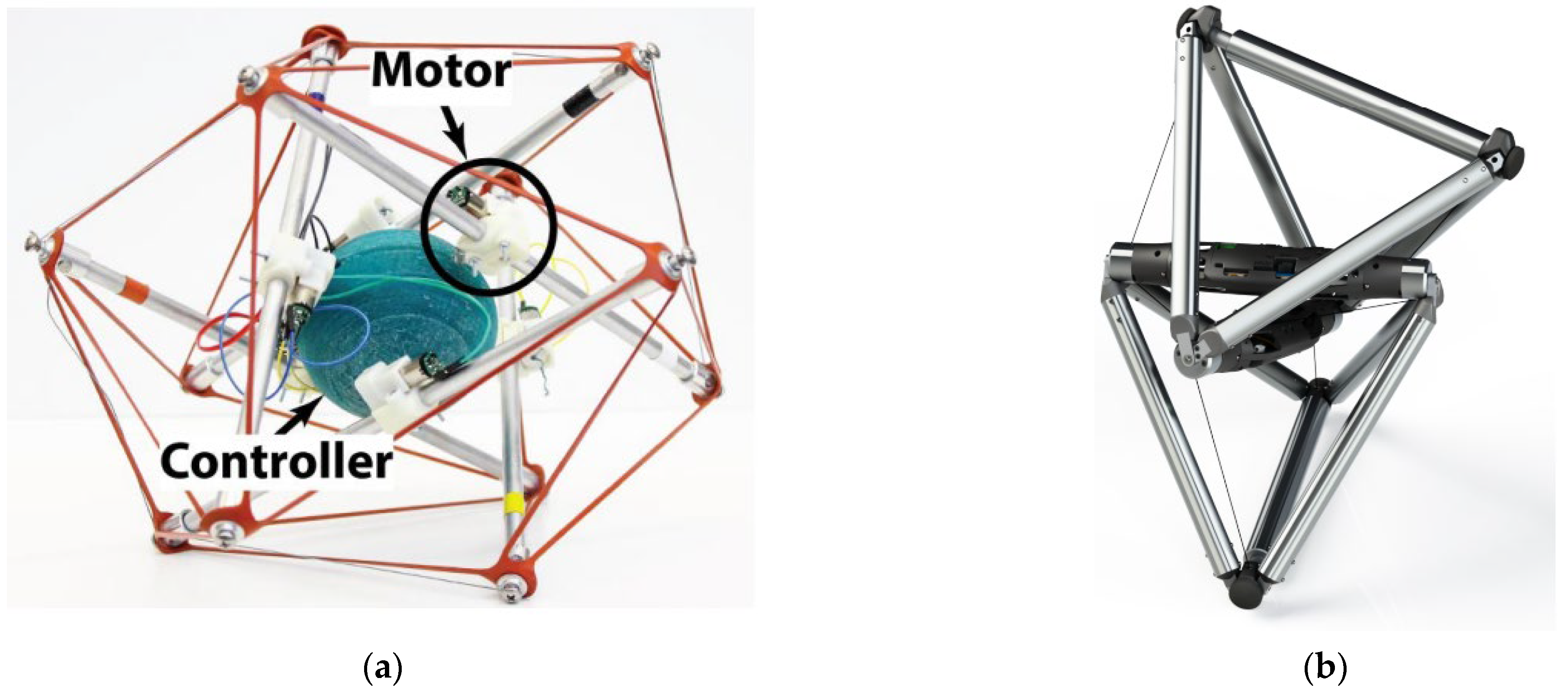
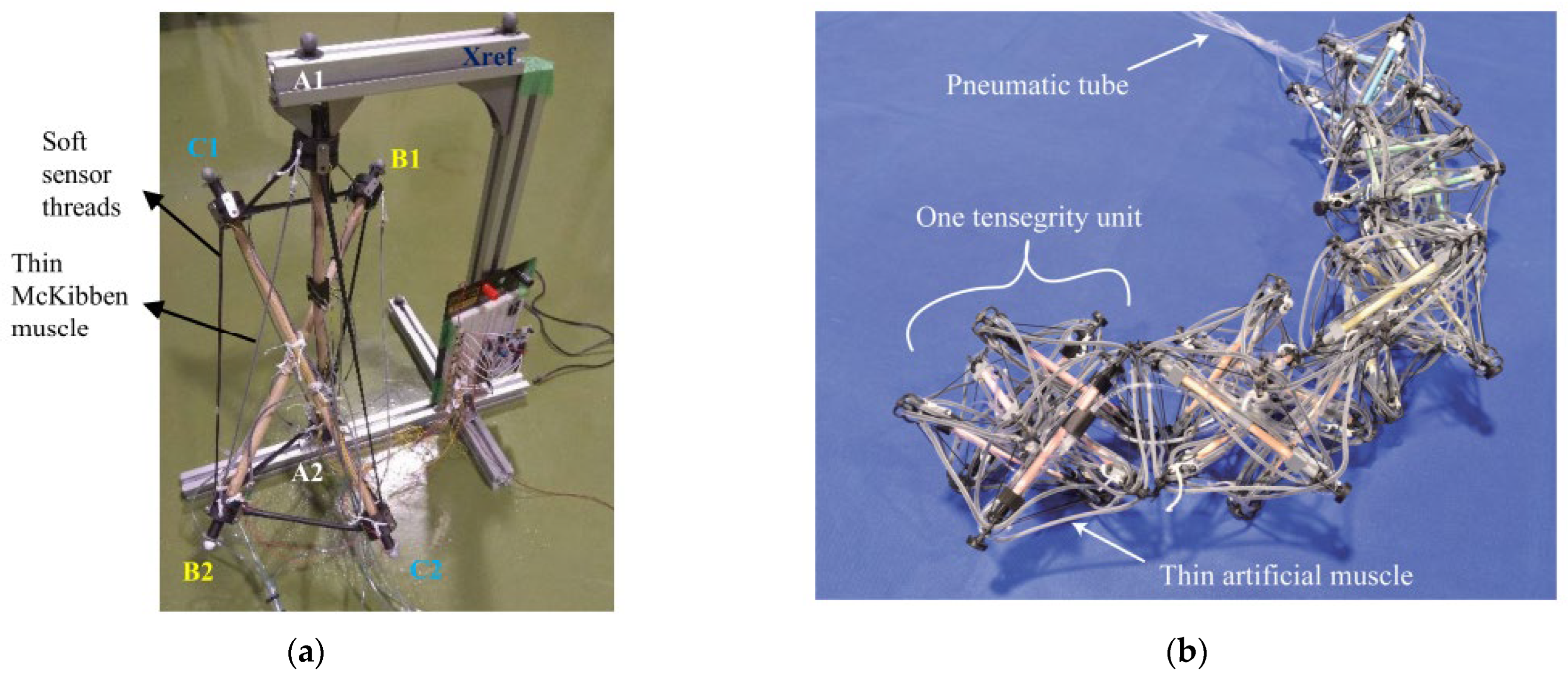

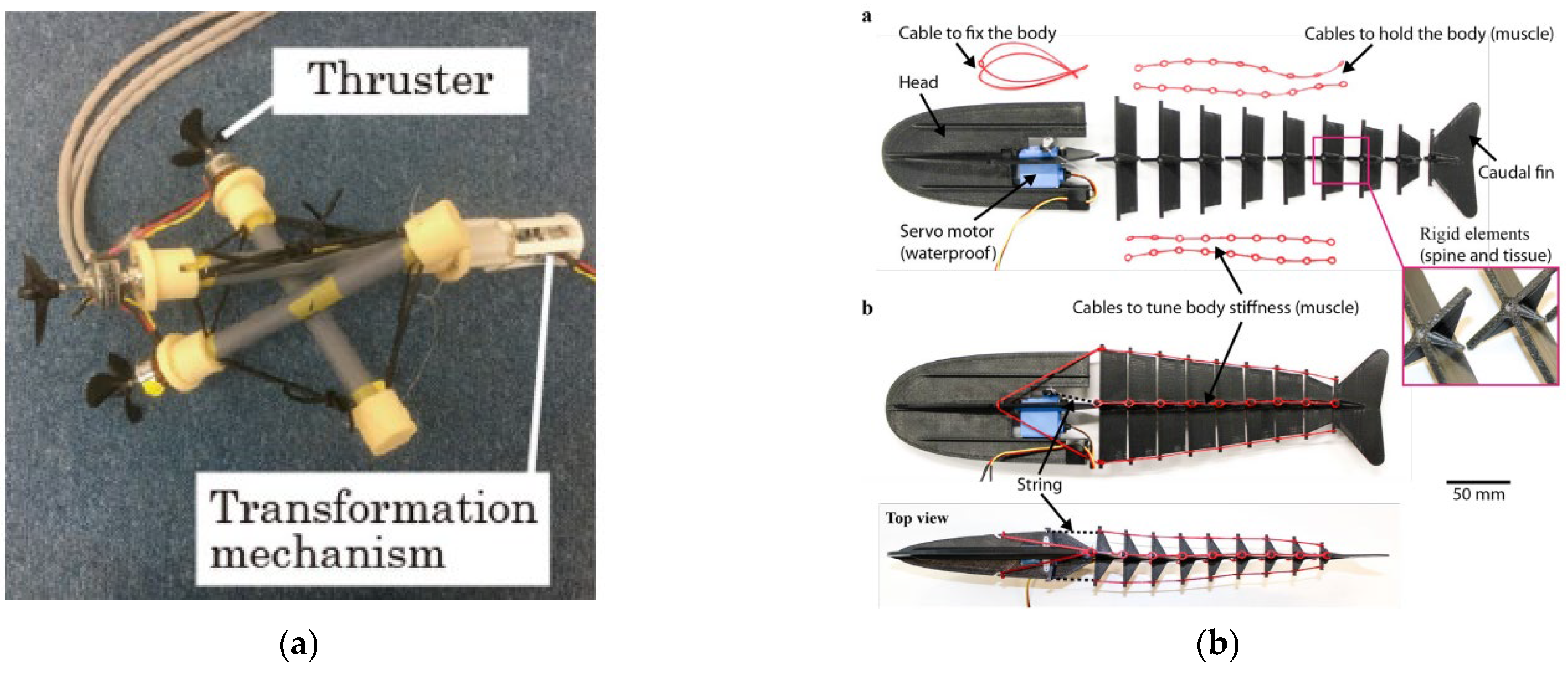
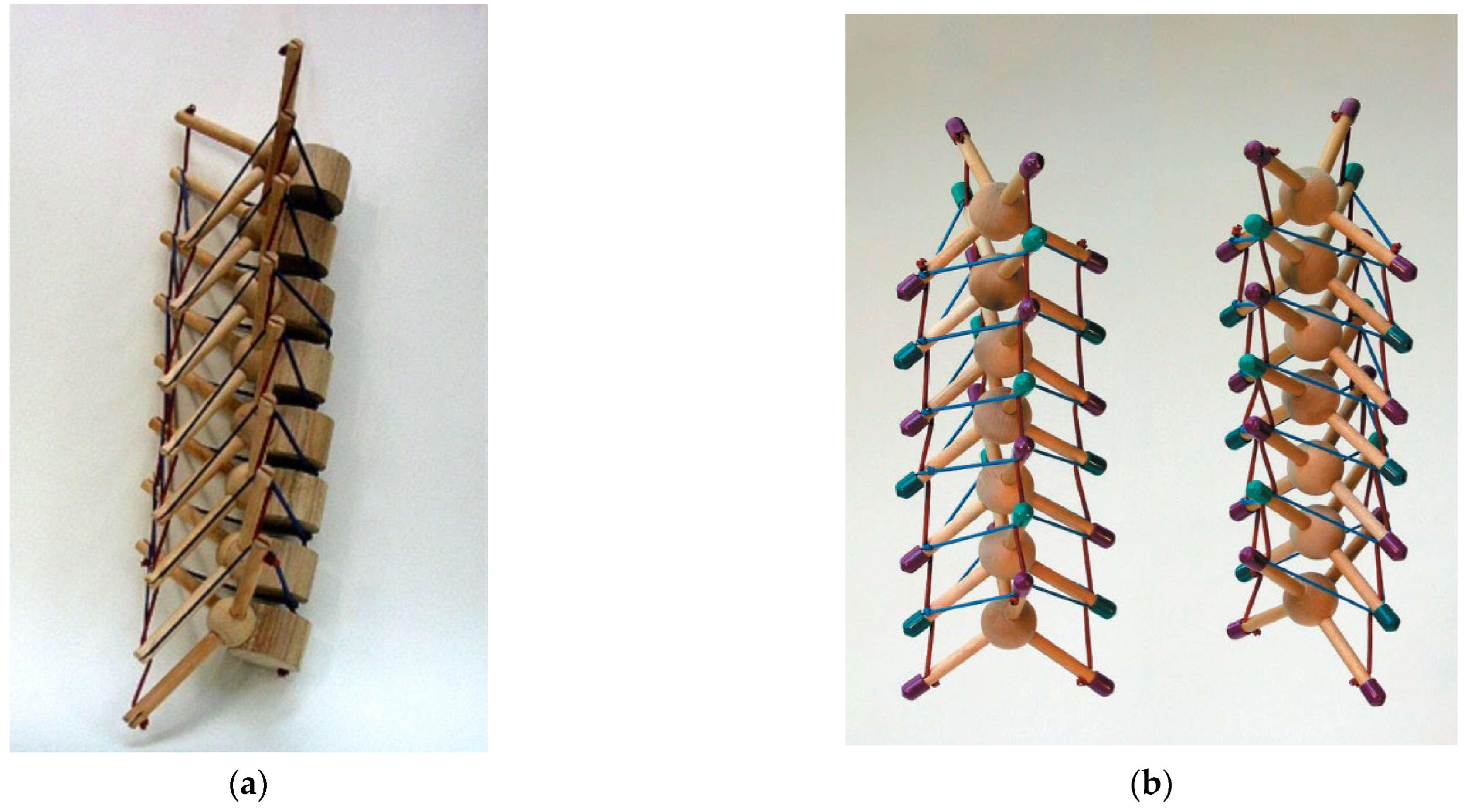

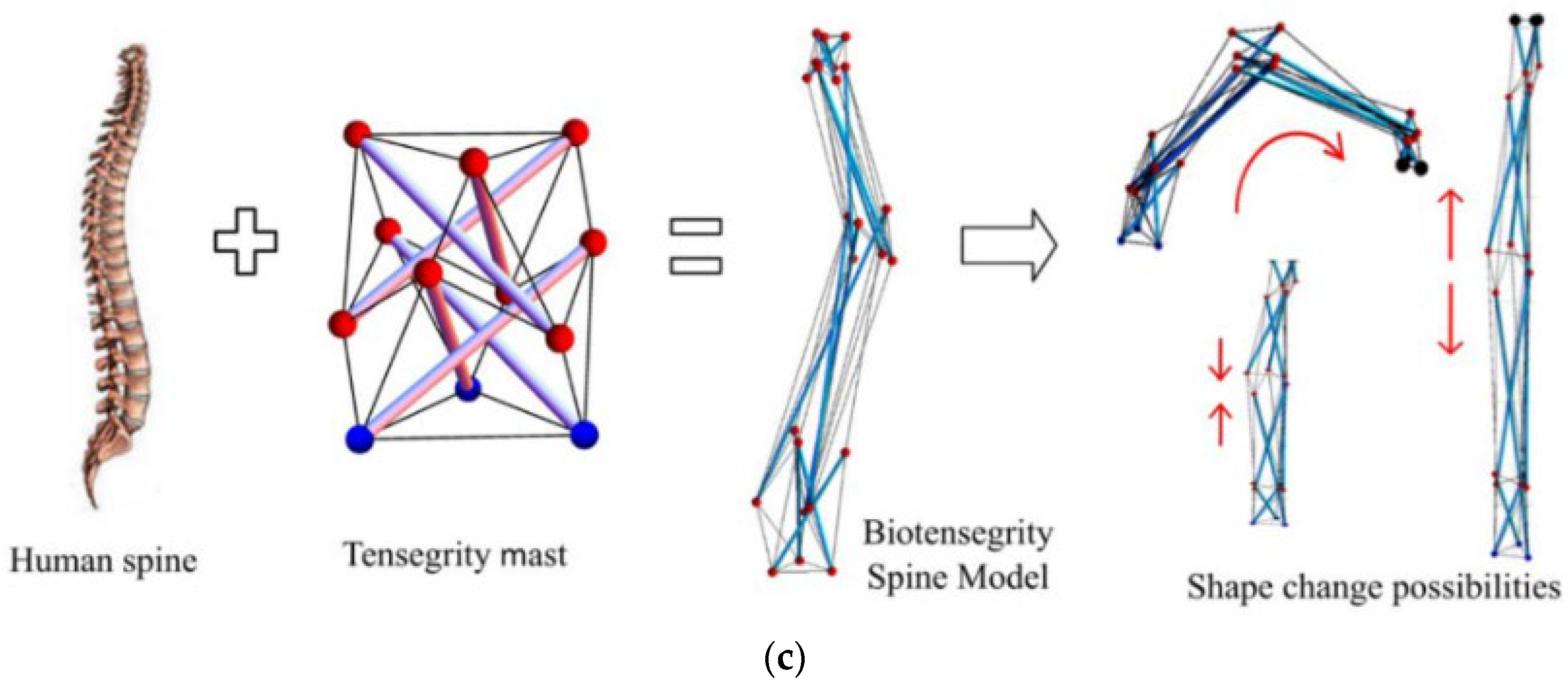
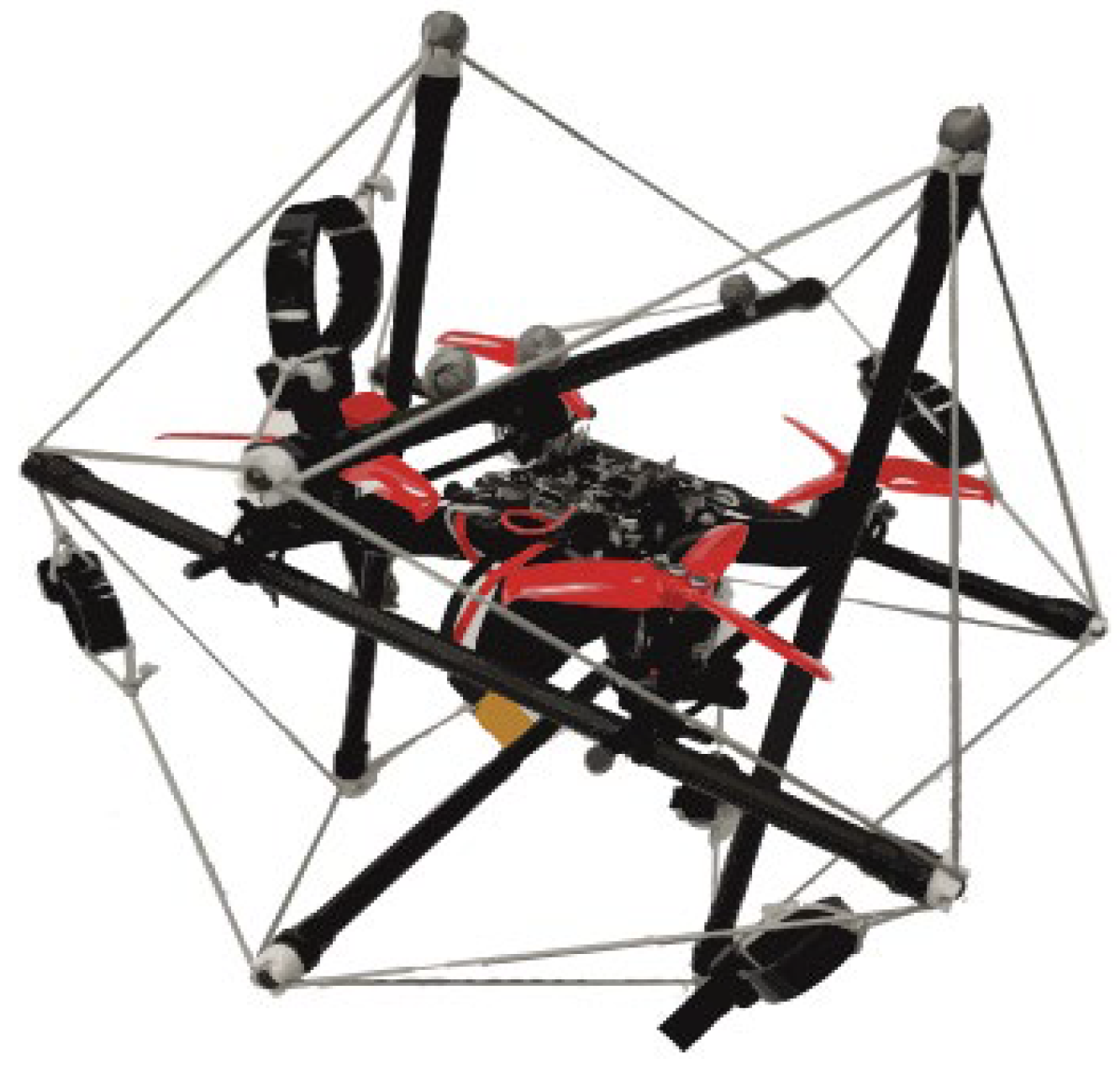
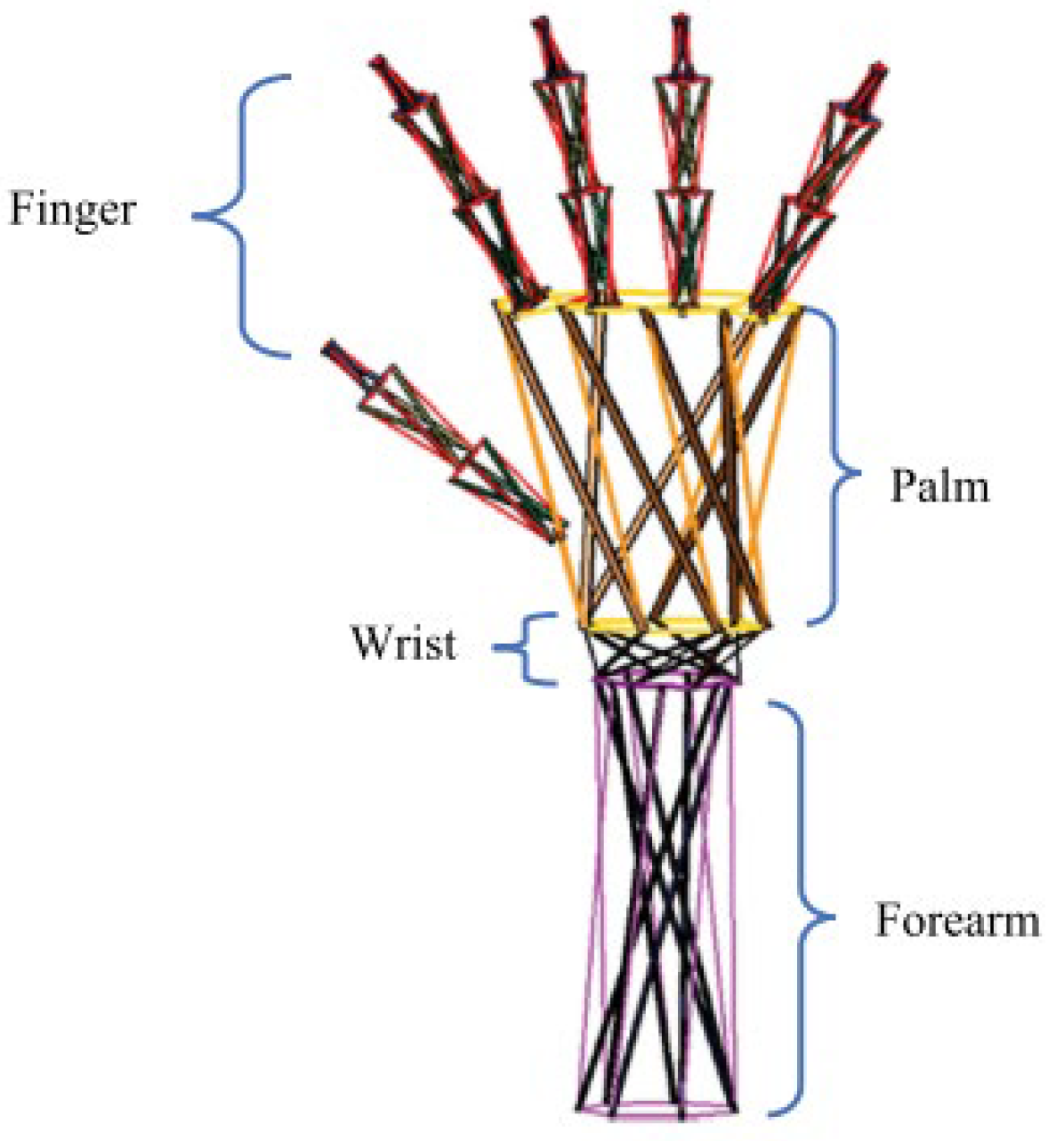

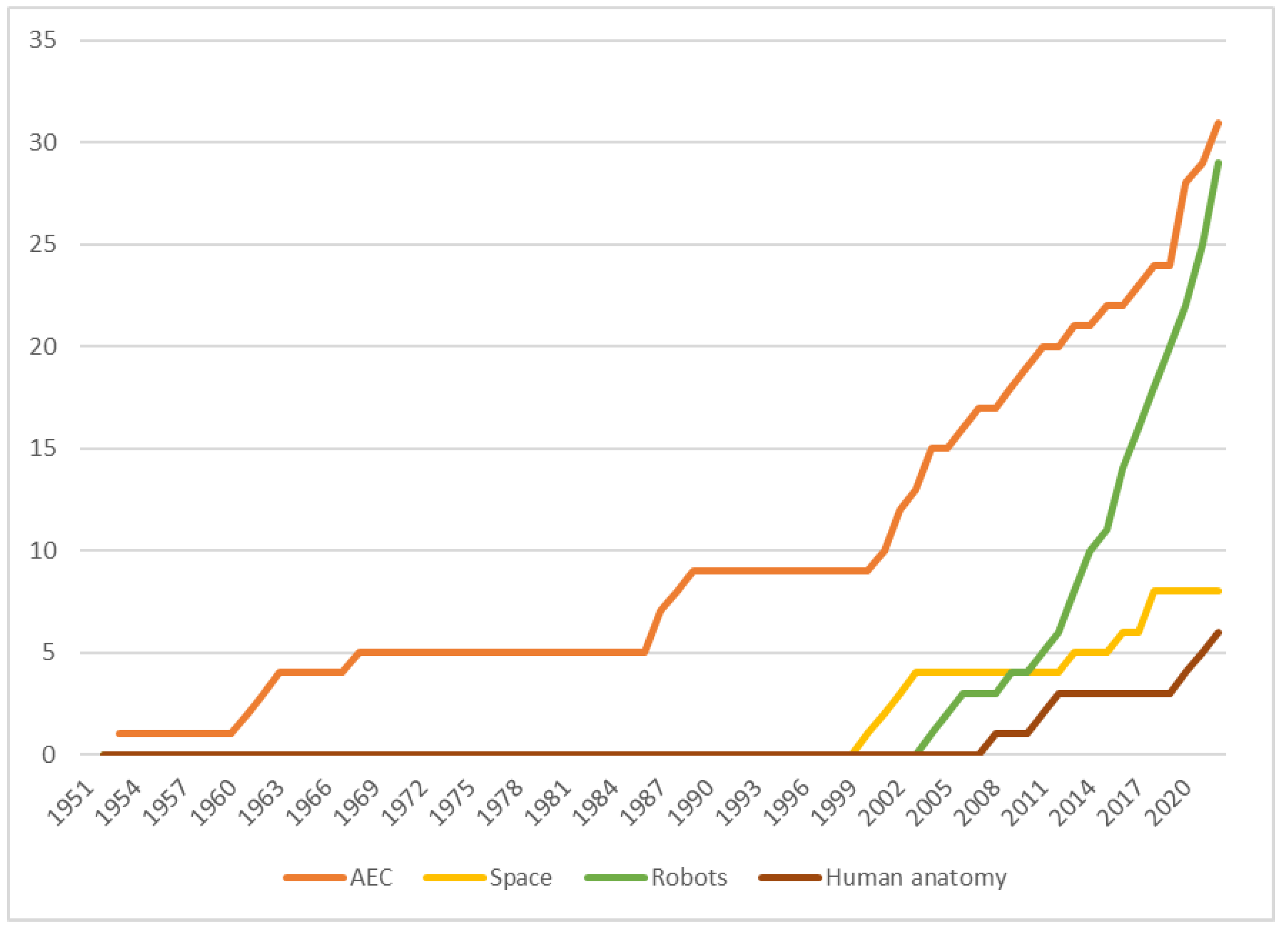
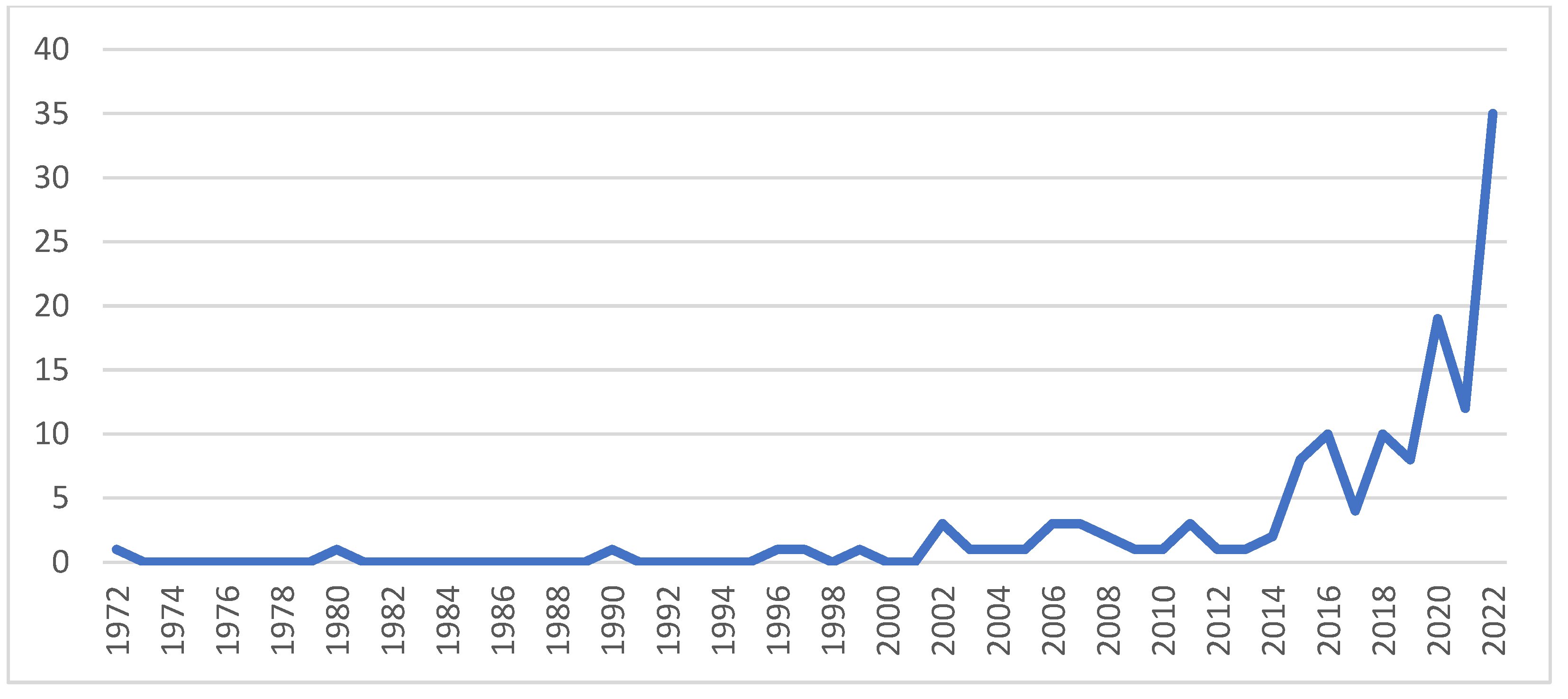

Disclaimer/Publisher’s Note: The statements, opinions and data contained in all publications are solely those of the individual author(s) and contributor(s) and not of MDPI and/or the editor(s). MDPI and/or the editor(s) disclaim responsibility for any injury to people or property resulting from any ideas, methods, instructions or products referred to in the content. |
© 2023 by the authors. Licensee MDPI, Basel, Switzerland. This article is an open access article distributed under the terms and conditions of the Creative Commons Attribution (CC BY) license (https://creativecommons.org/licenses/by/4.0/).
Share and Cite
Gomez-Jauregui, V.; Carrillo-Rodriguez, A.; Manchado, C.; Lastra-Gonzalez, P. Tensegrity Applications to Architecture, Engineering and Robotics: A Review. Appl. Sci. 2023, 13, 8669. https://doi.org/10.3390/app13158669
Gomez-Jauregui V, Carrillo-Rodriguez A, Manchado C, Lastra-Gonzalez P. Tensegrity Applications to Architecture, Engineering and Robotics: A Review. Applied Sciences. 2023; 13(15):8669. https://doi.org/10.3390/app13158669
Chicago/Turabian StyleGomez-Jauregui, Valentin, Angela Carrillo-Rodriguez, Cristina Manchado, and Pedro Lastra-Gonzalez. 2023. "Tensegrity Applications to Architecture, Engineering and Robotics: A Review" Applied Sciences 13, no. 15: 8669. https://doi.org/10.3390/app13158669
APA StyleGomez-Jauregui, V., Carrillo-Rodriguez, A., Manchado, C., & Lastra-Gonzalez, P. (2023). Tensegrity Applications to Architecture, Engineering and Robotics: A Review. Applied Sciences, 13(15), 8669. https://doi.org/10.3390/app13158669







